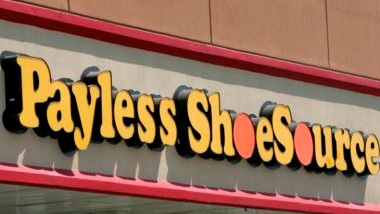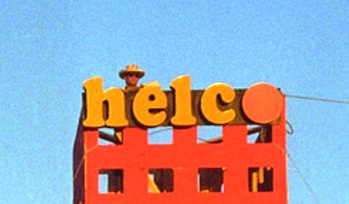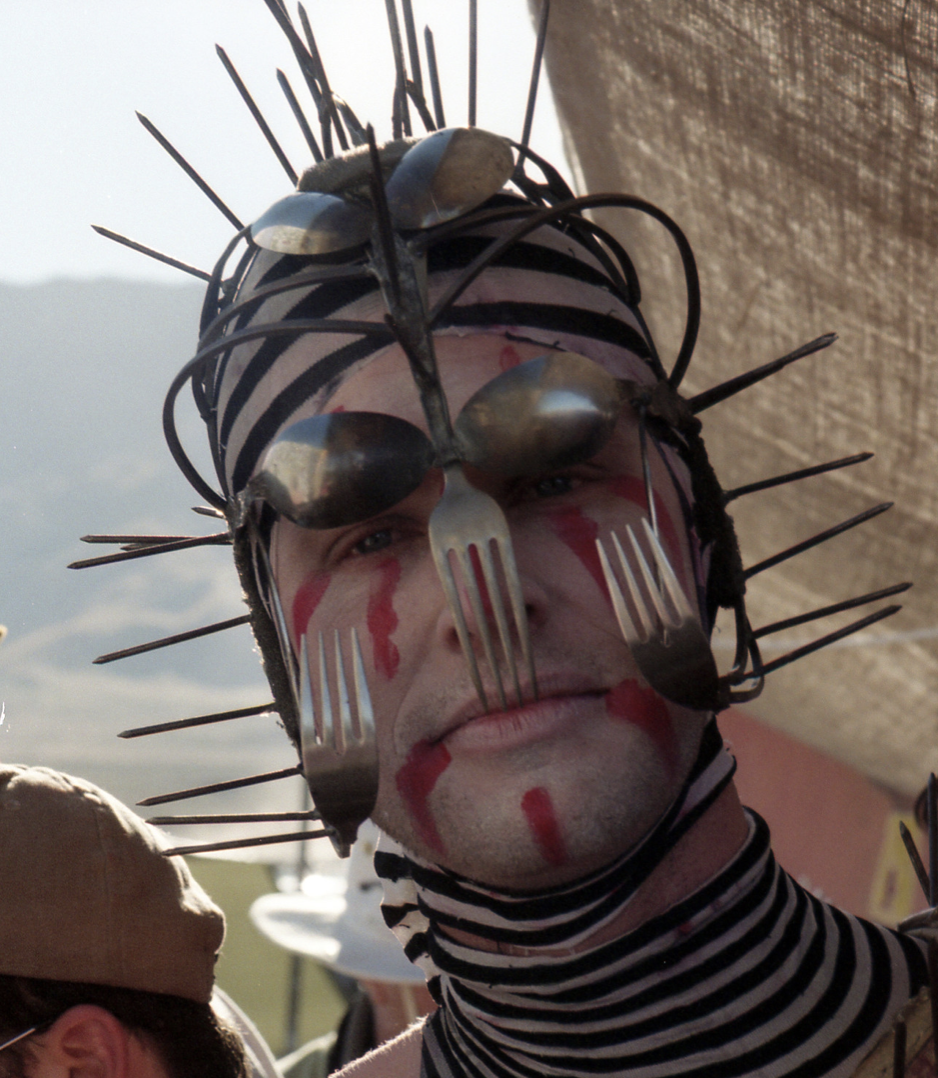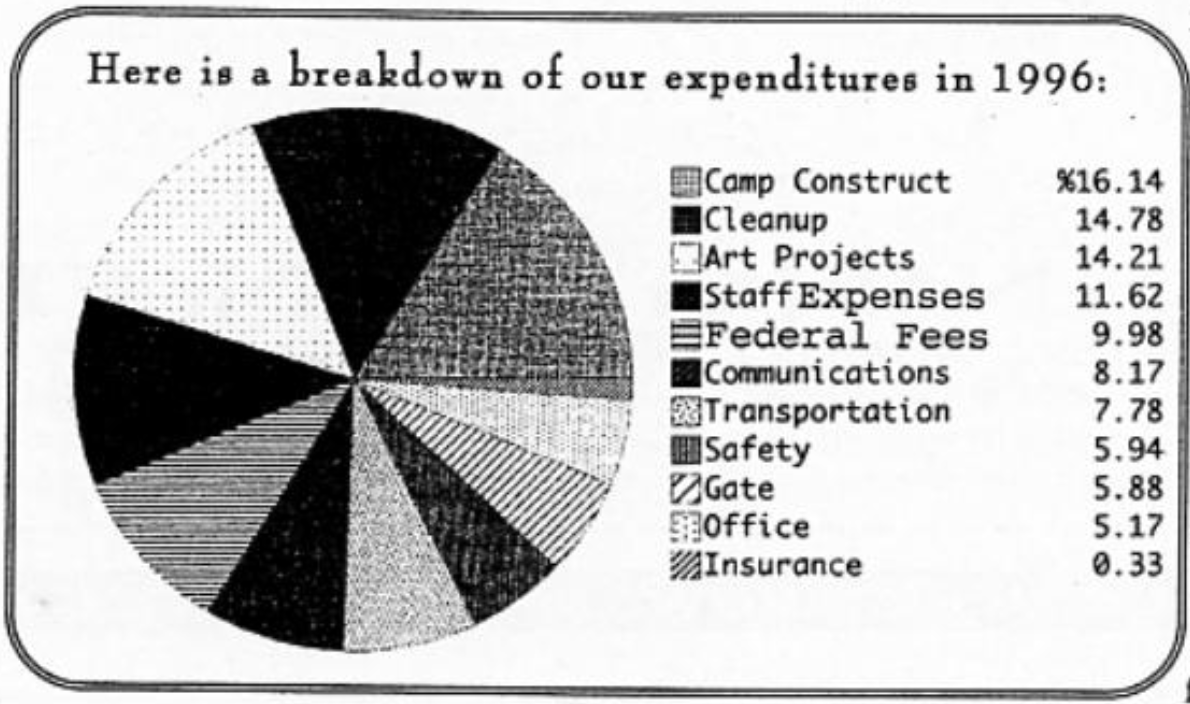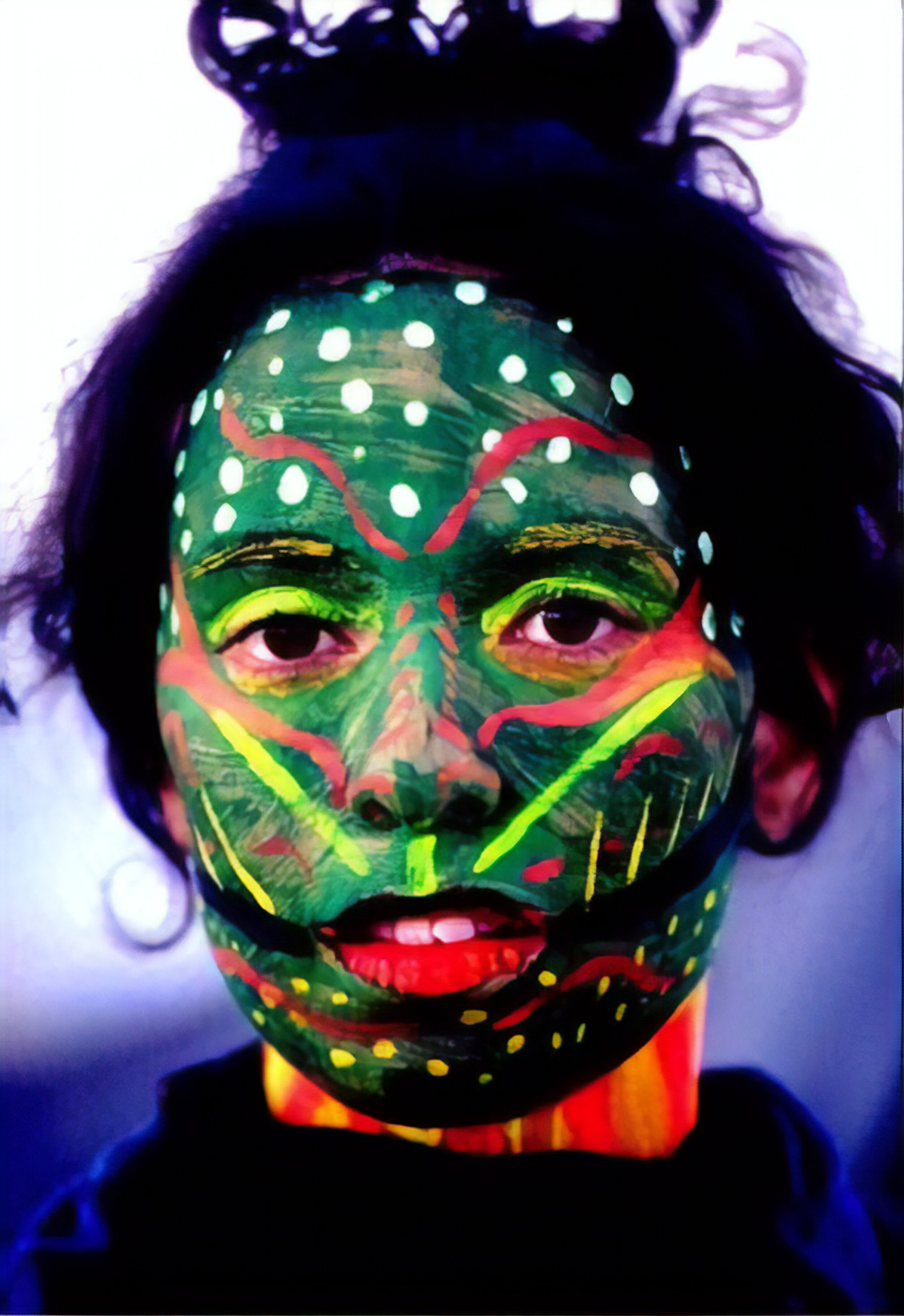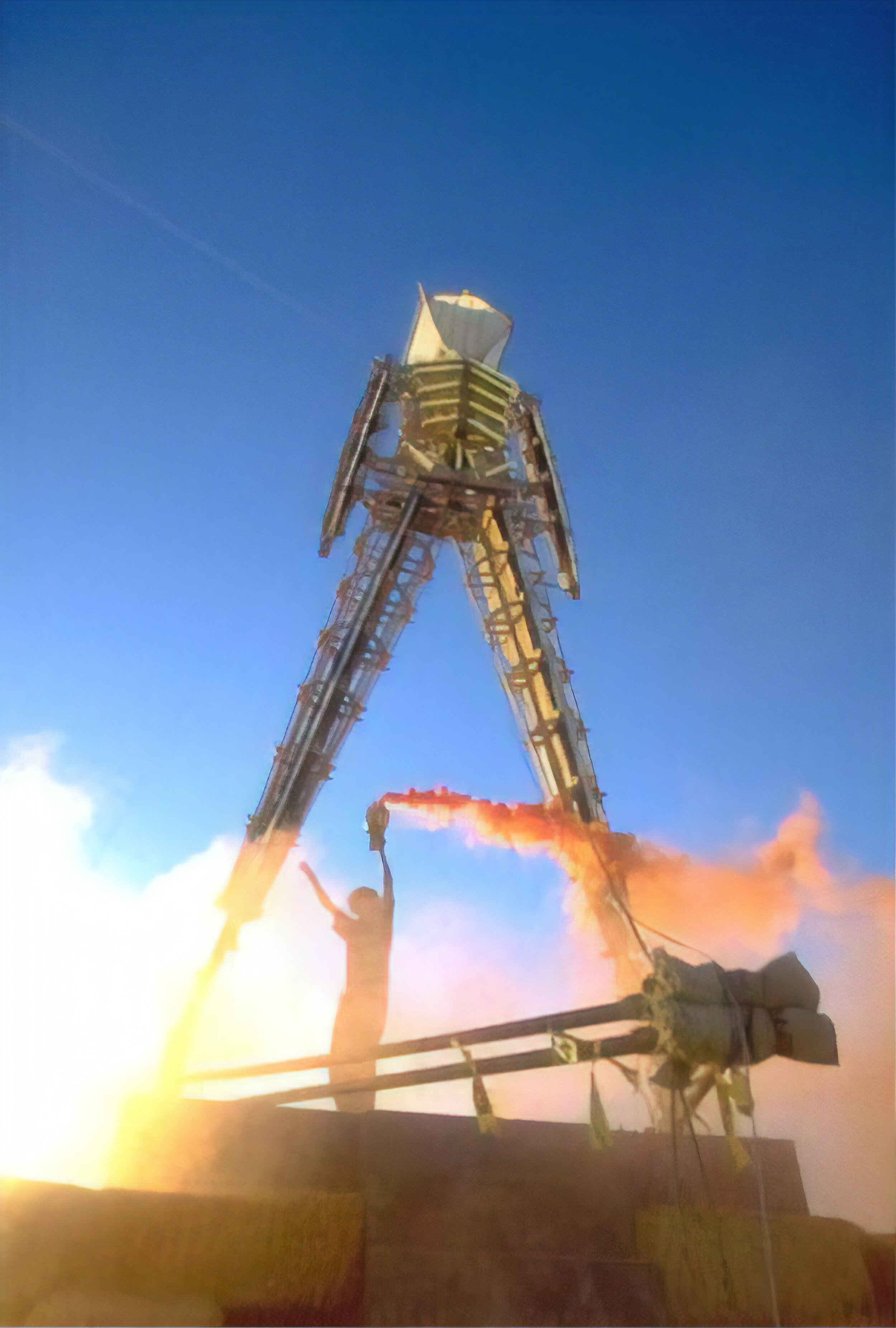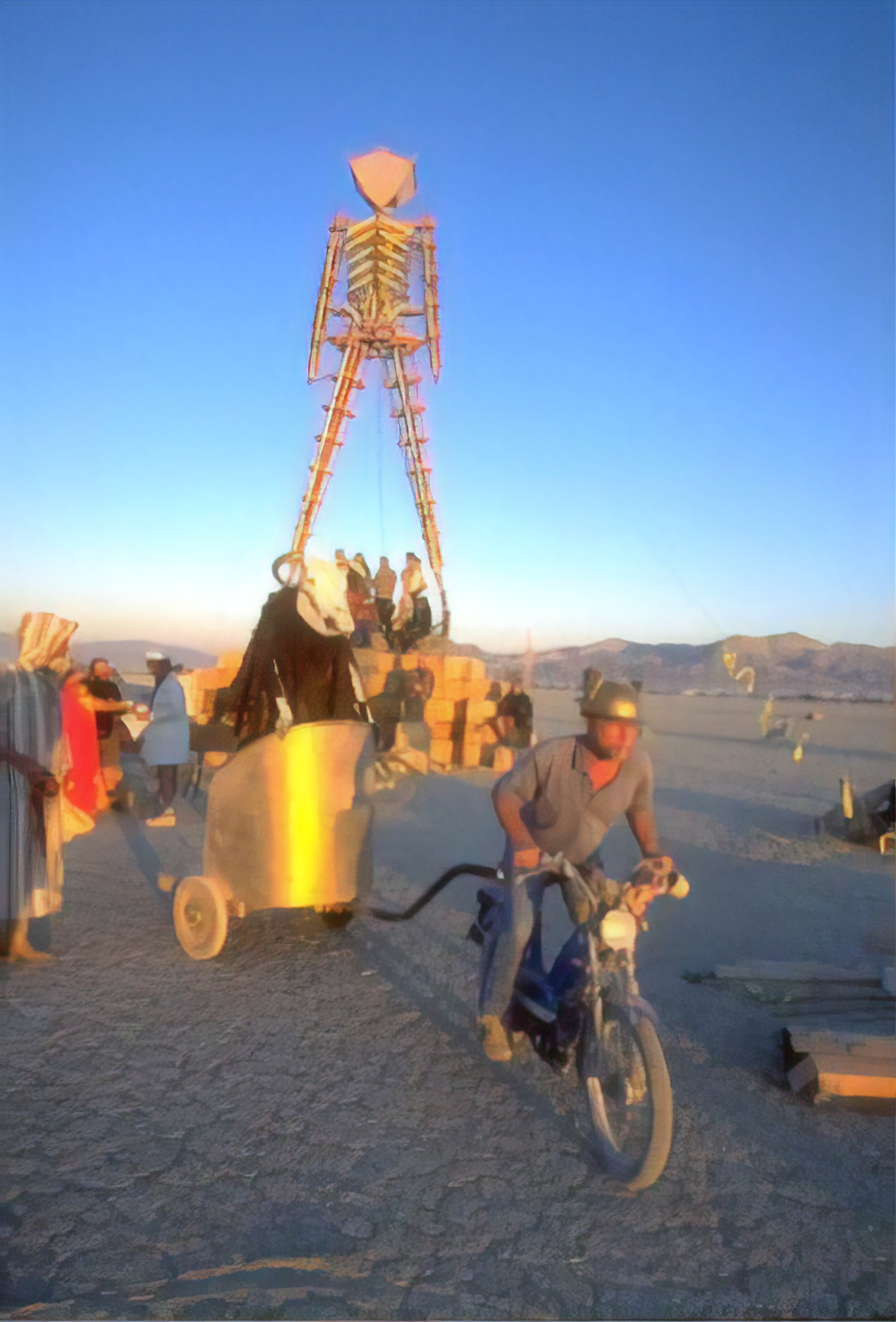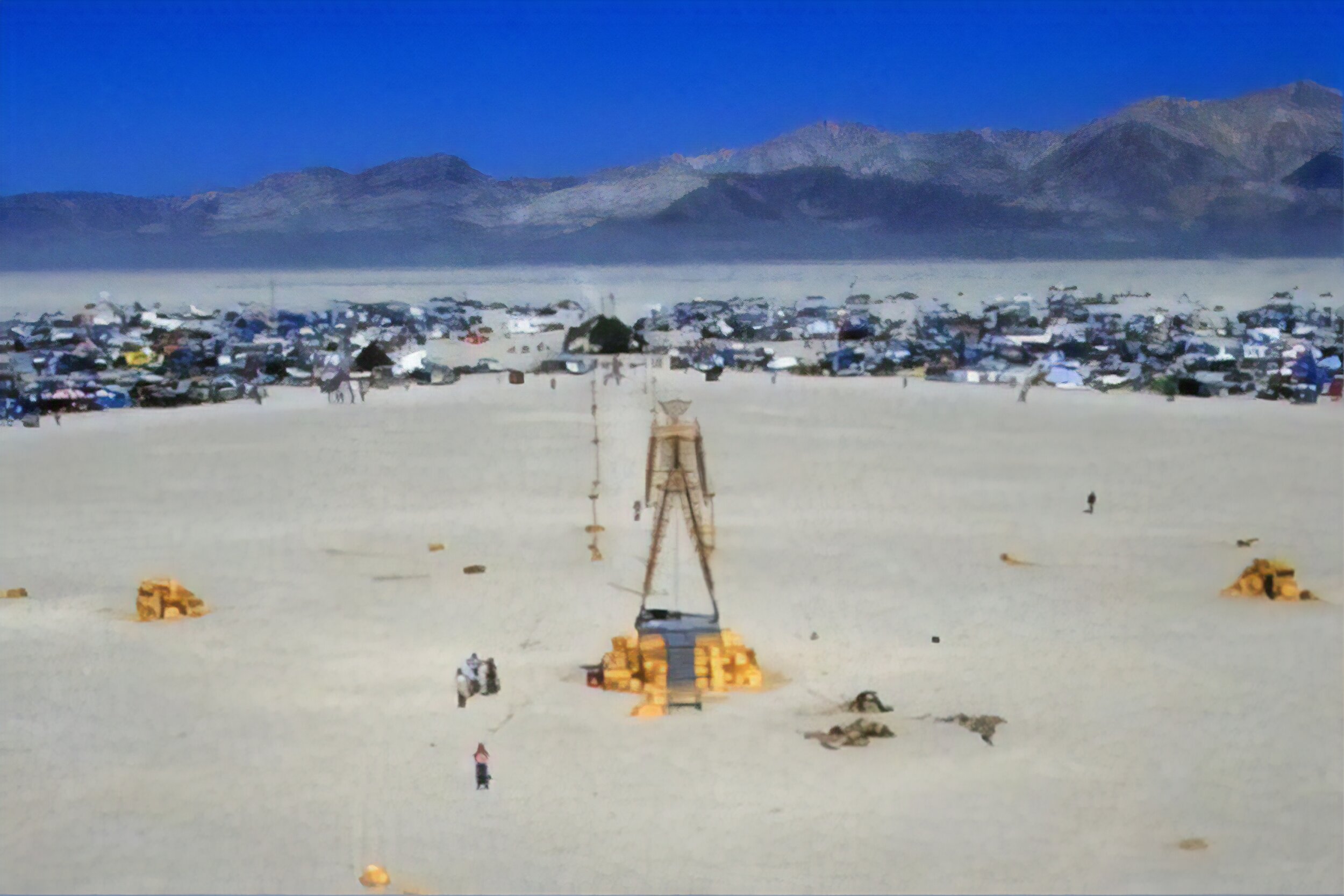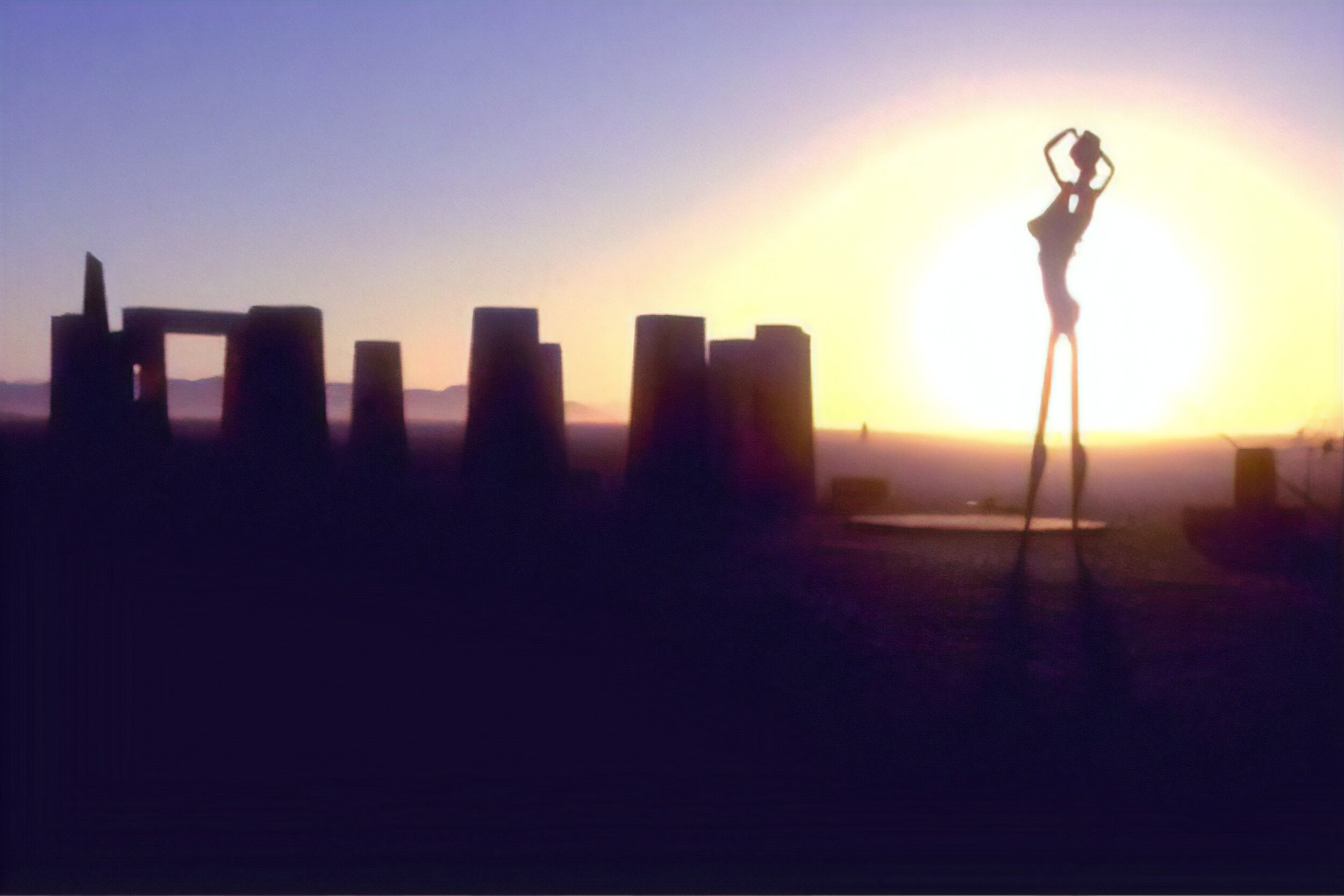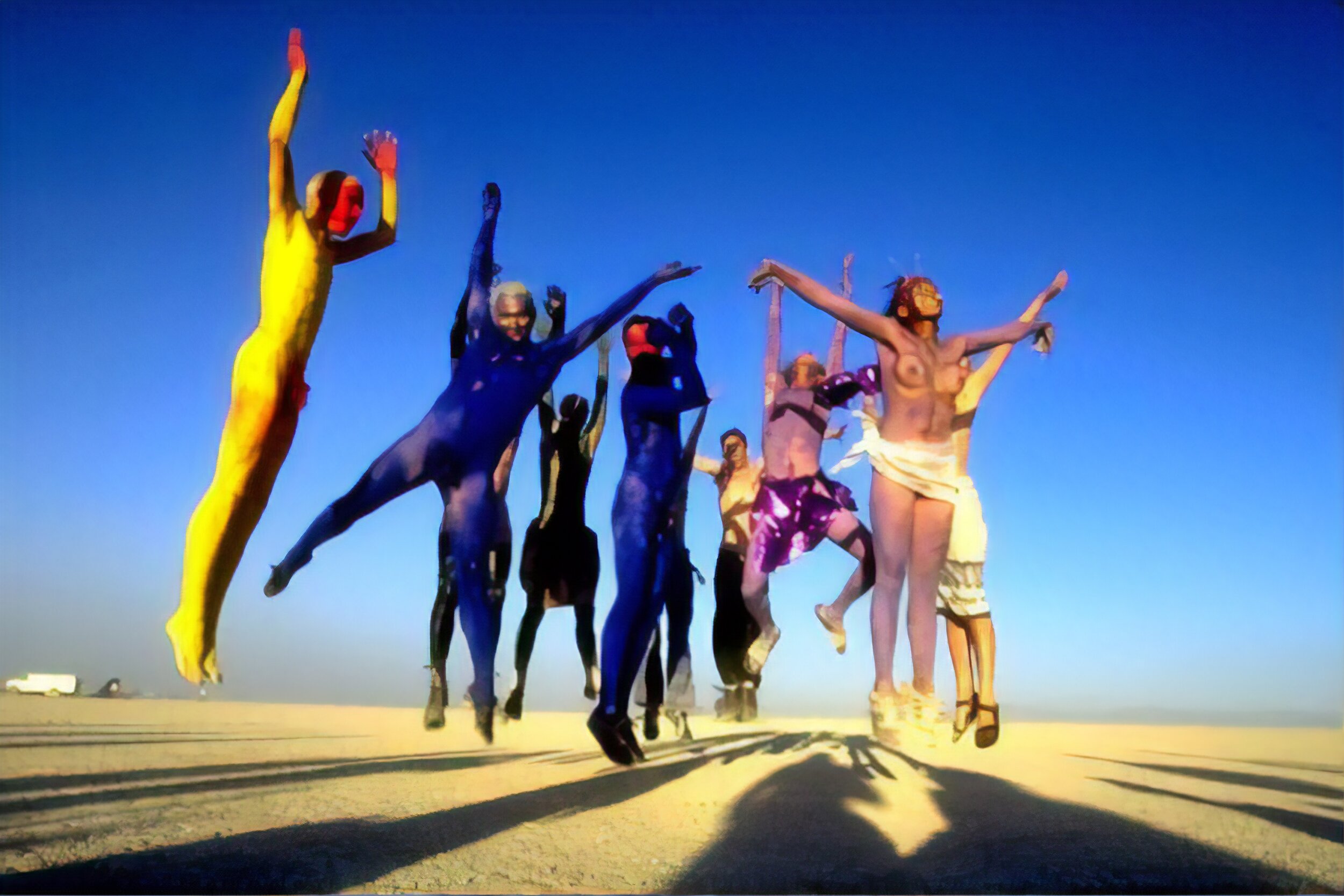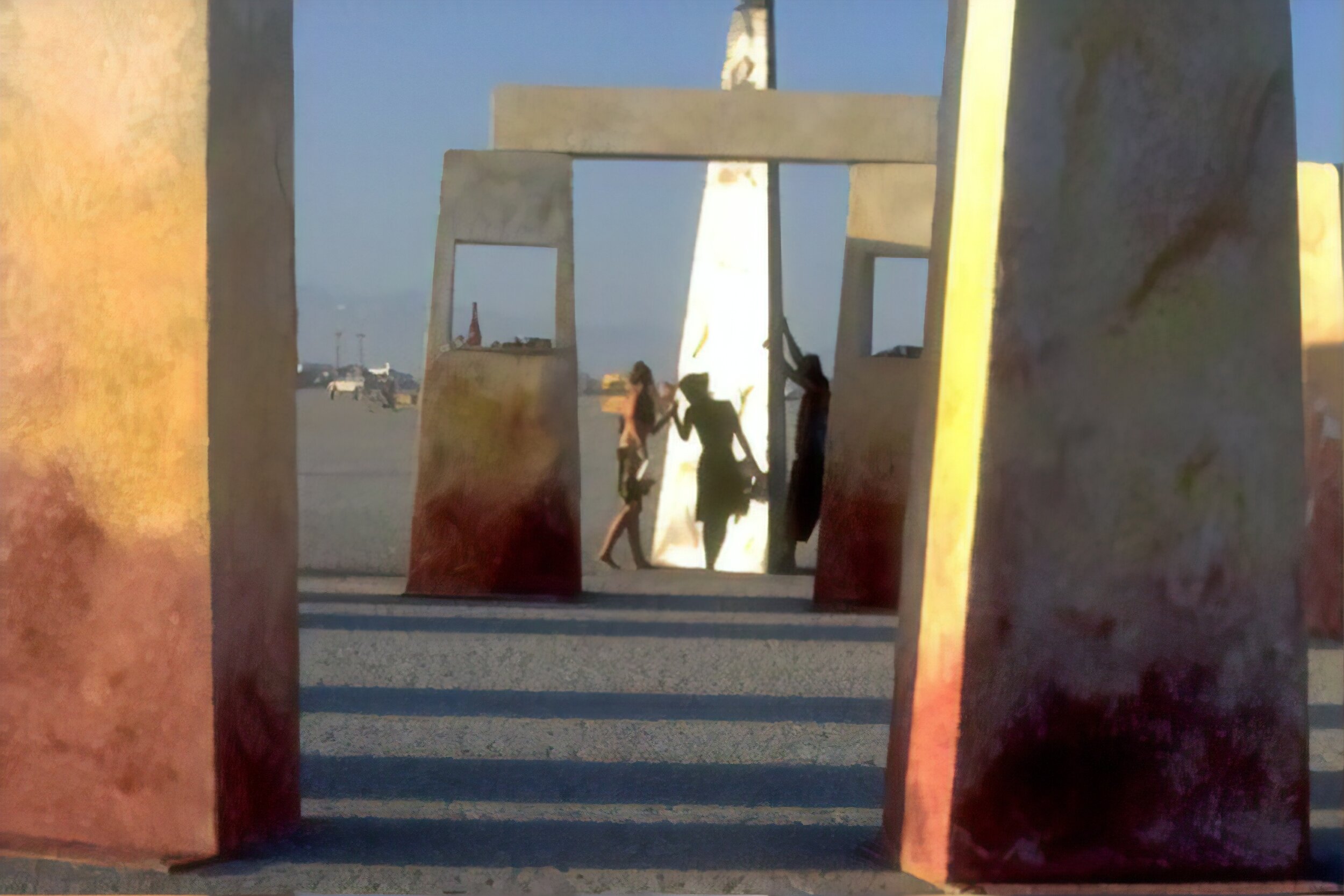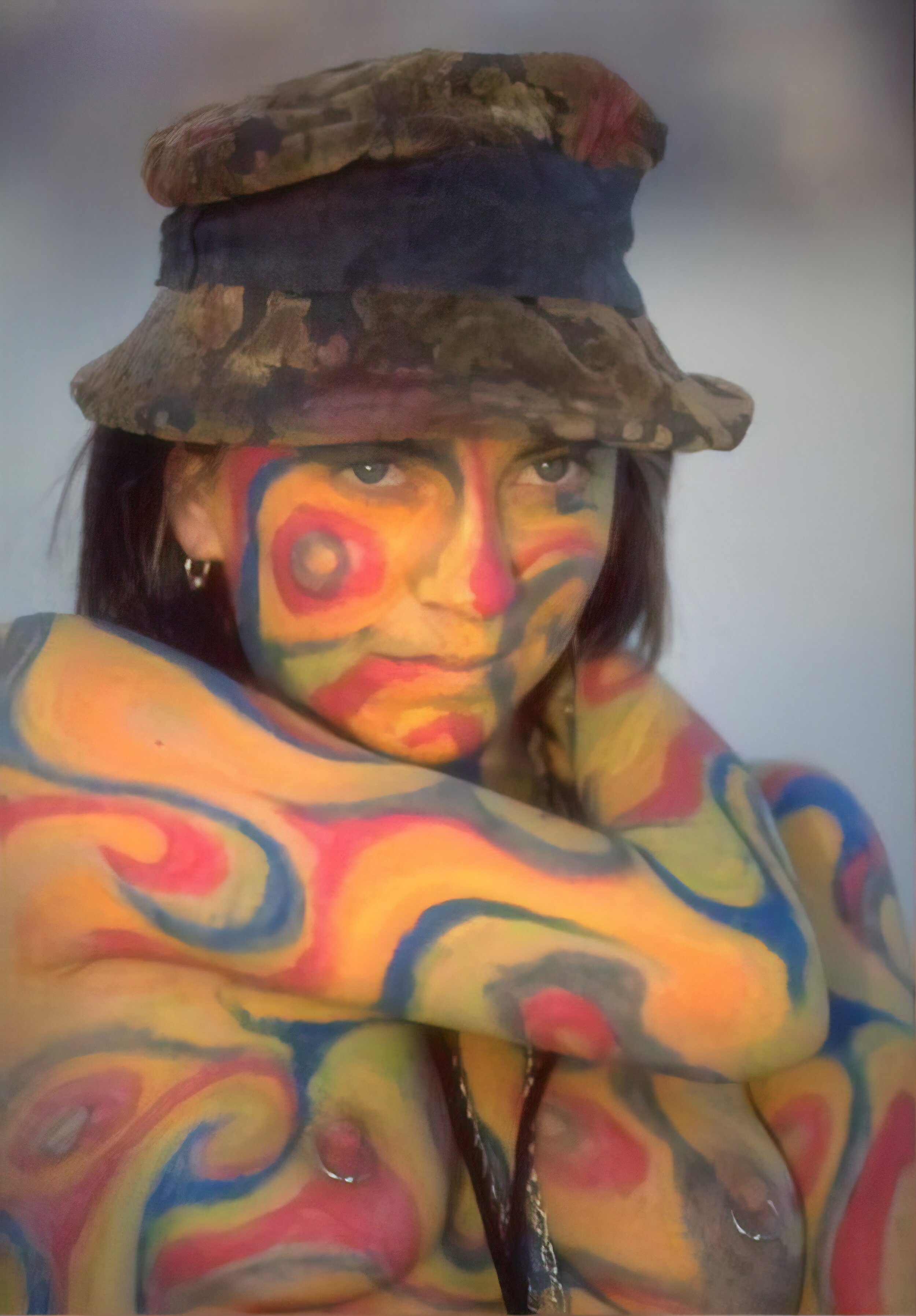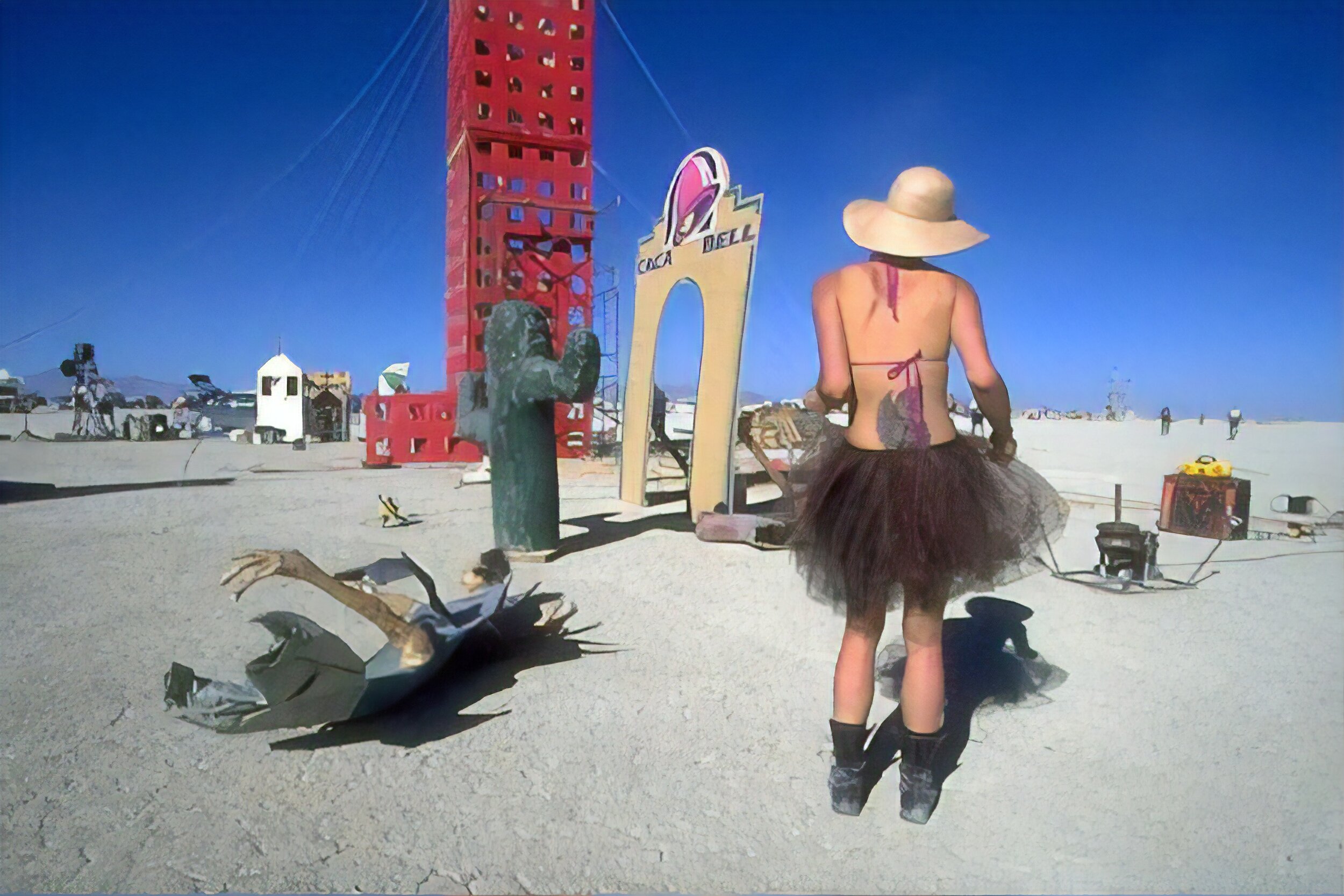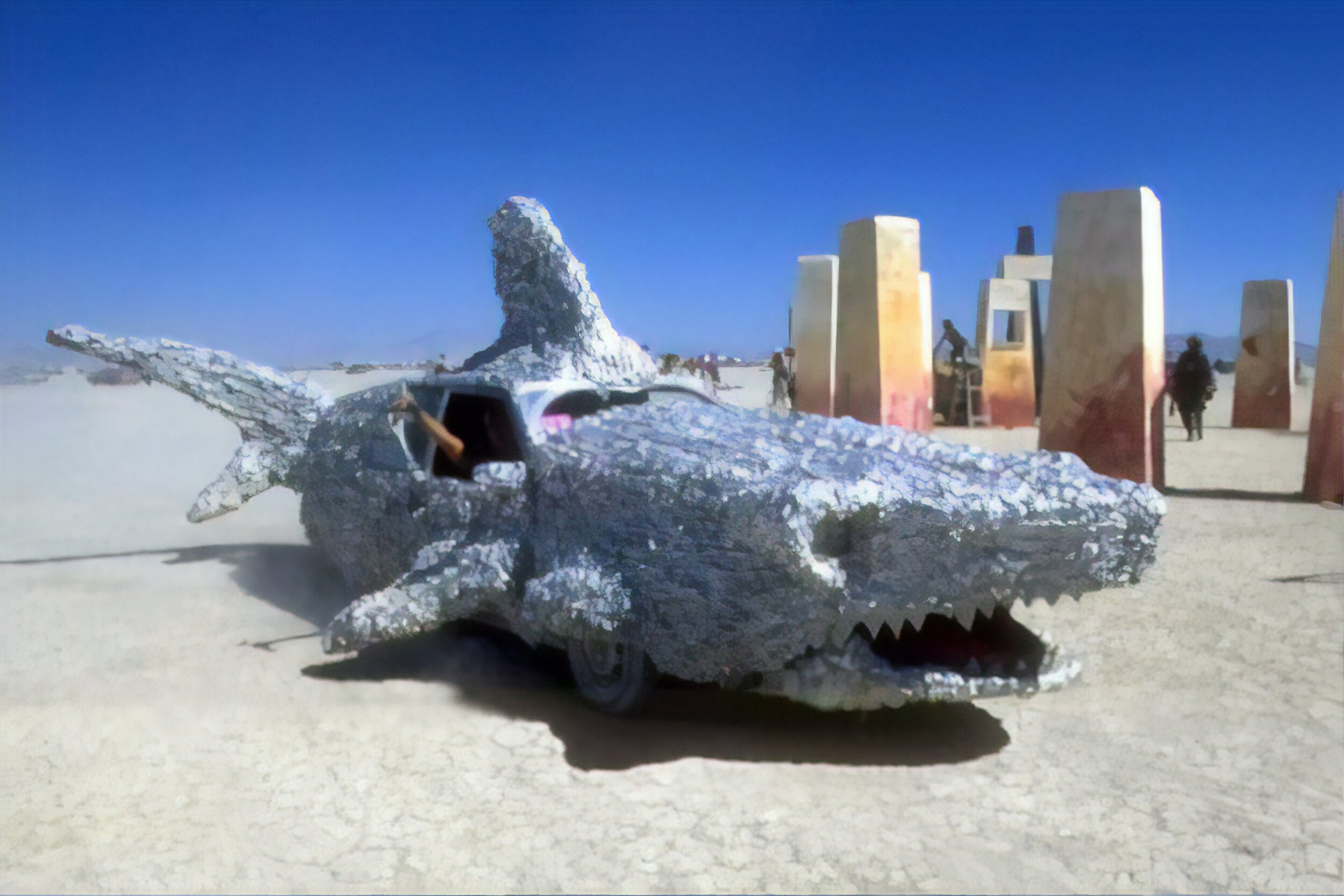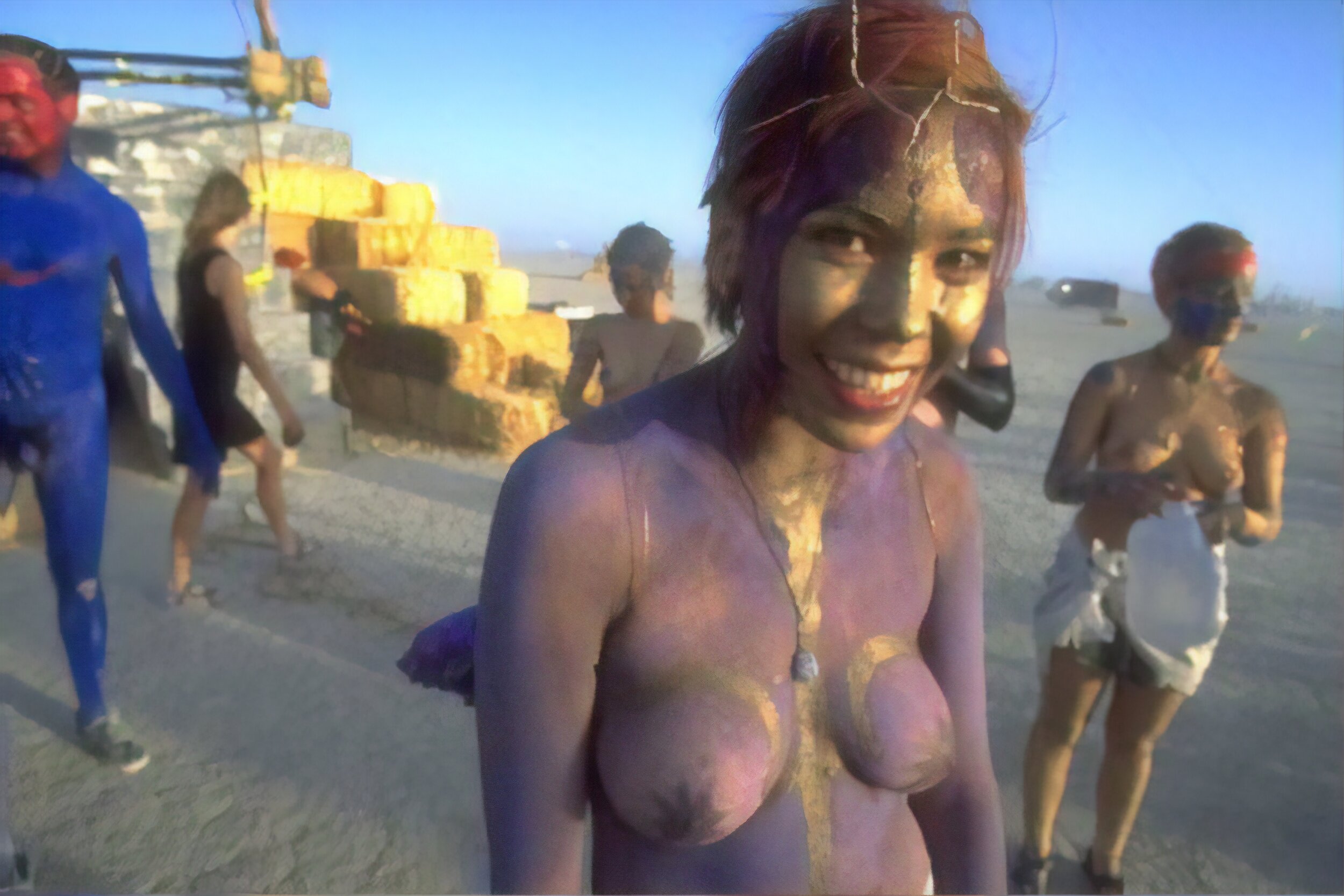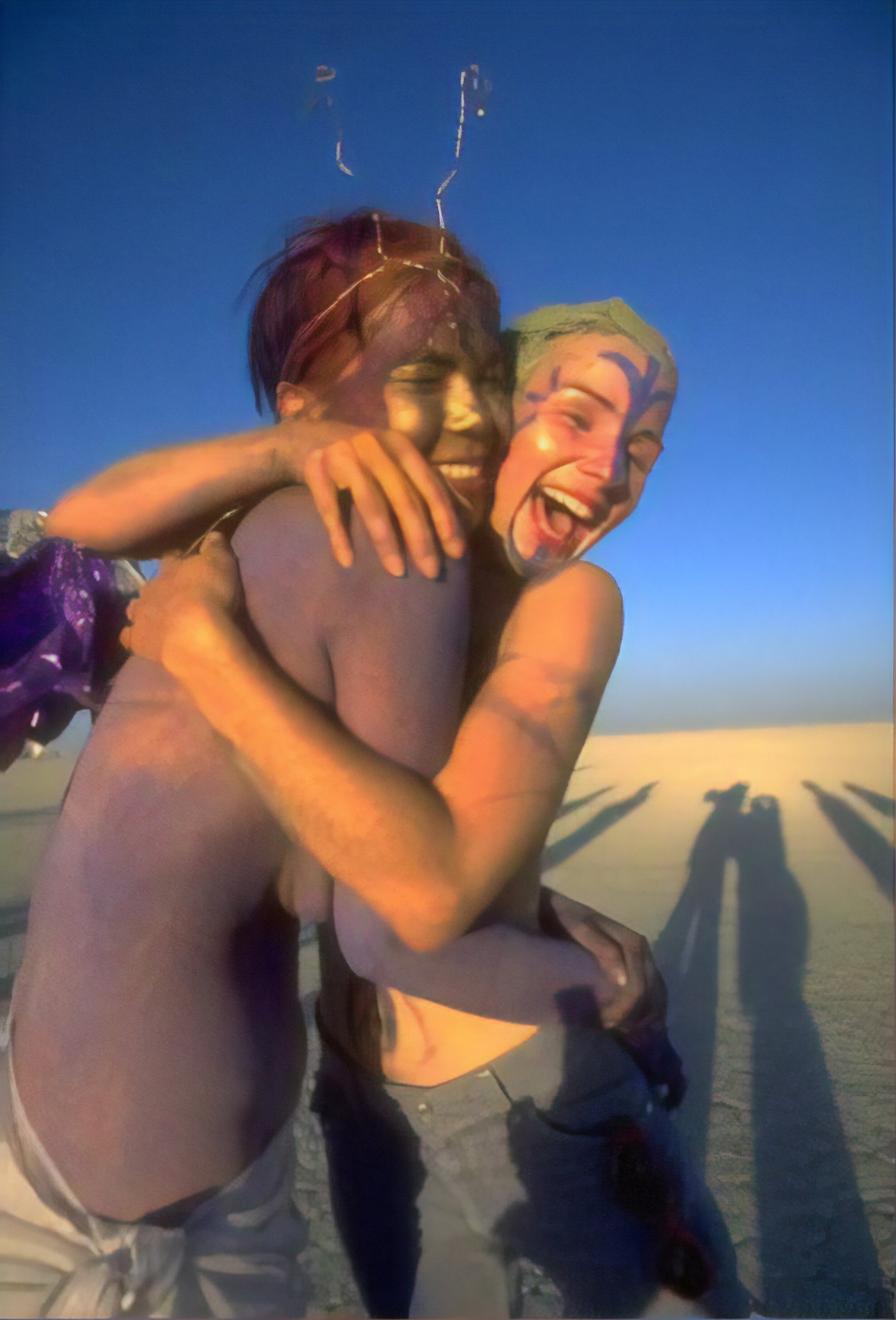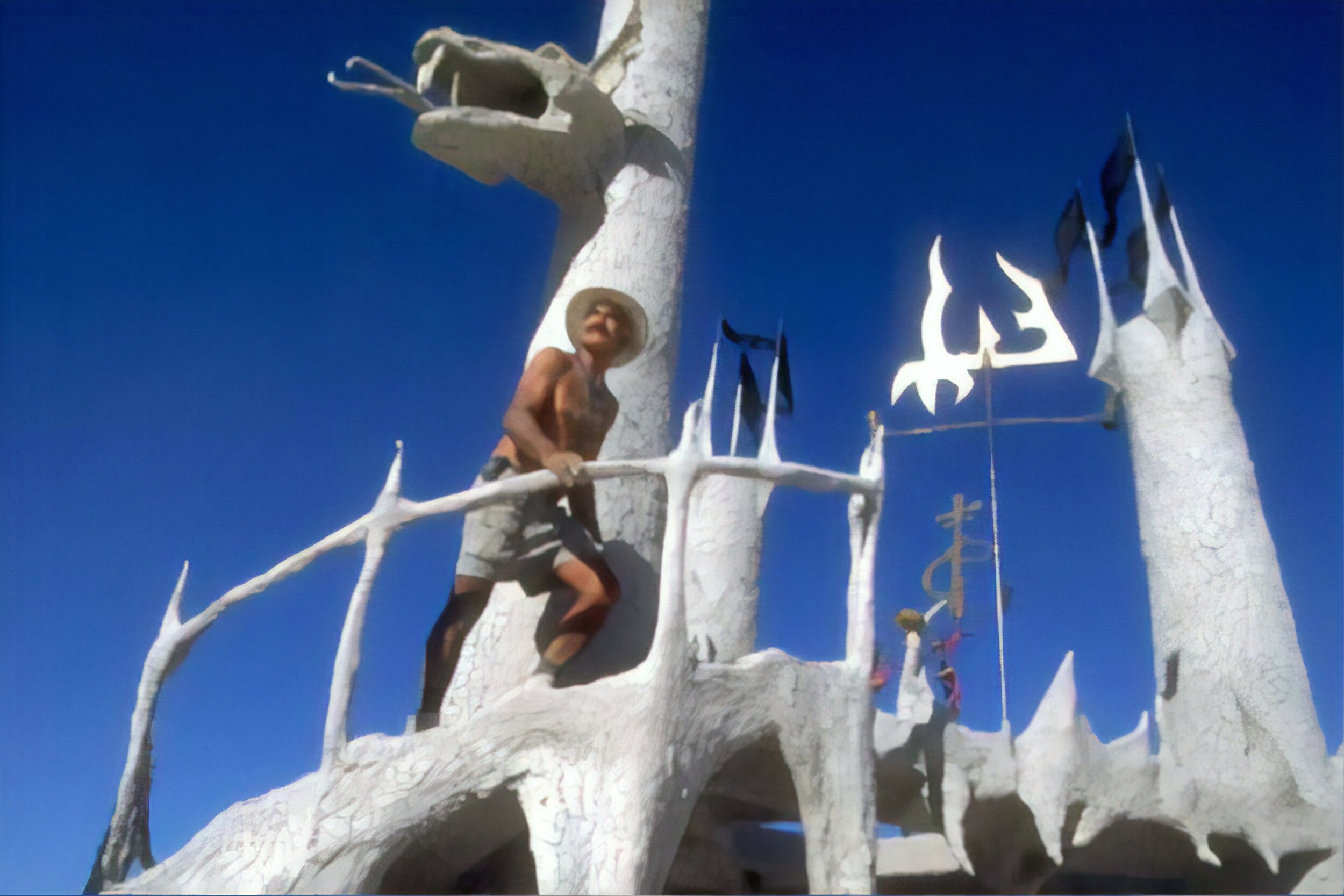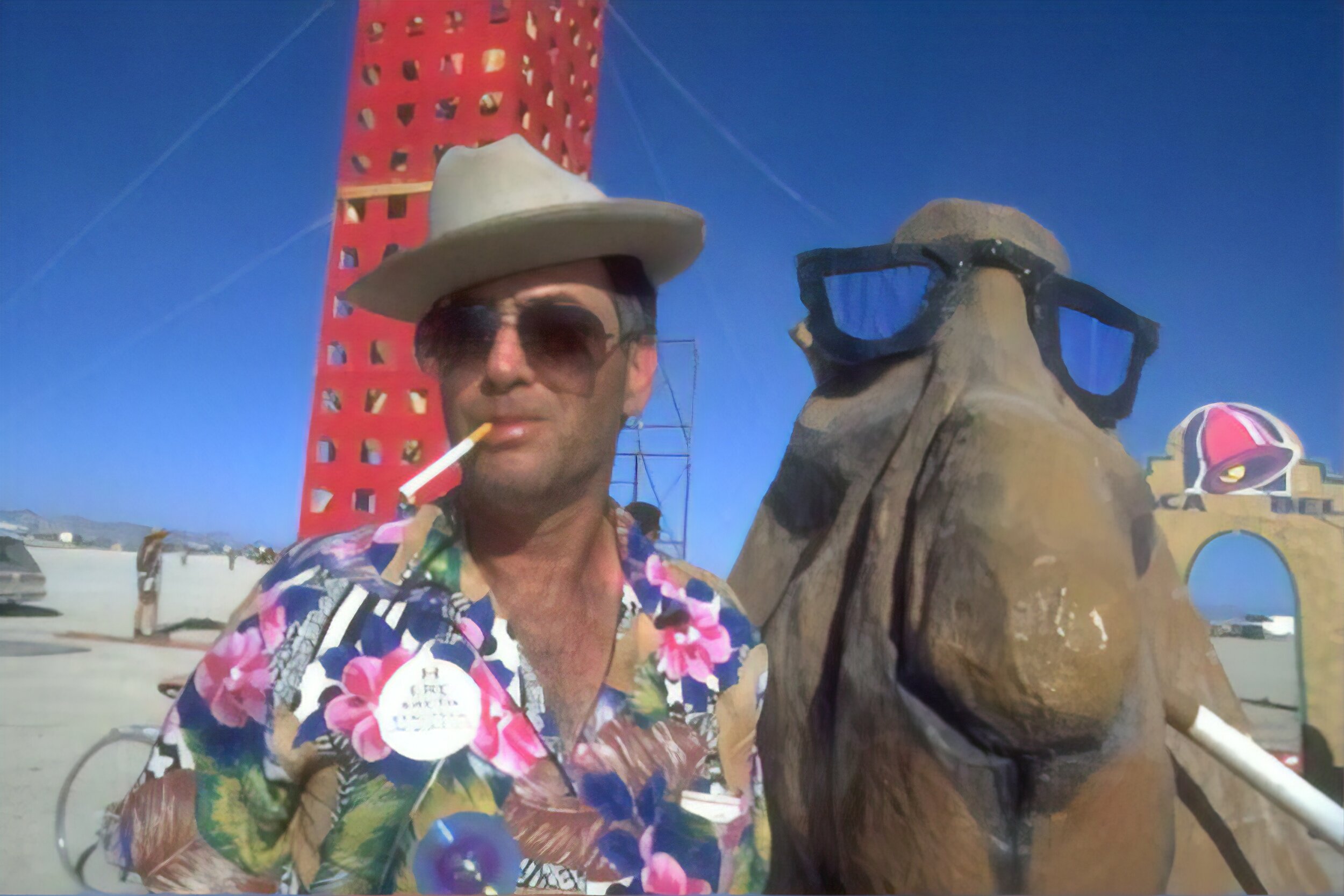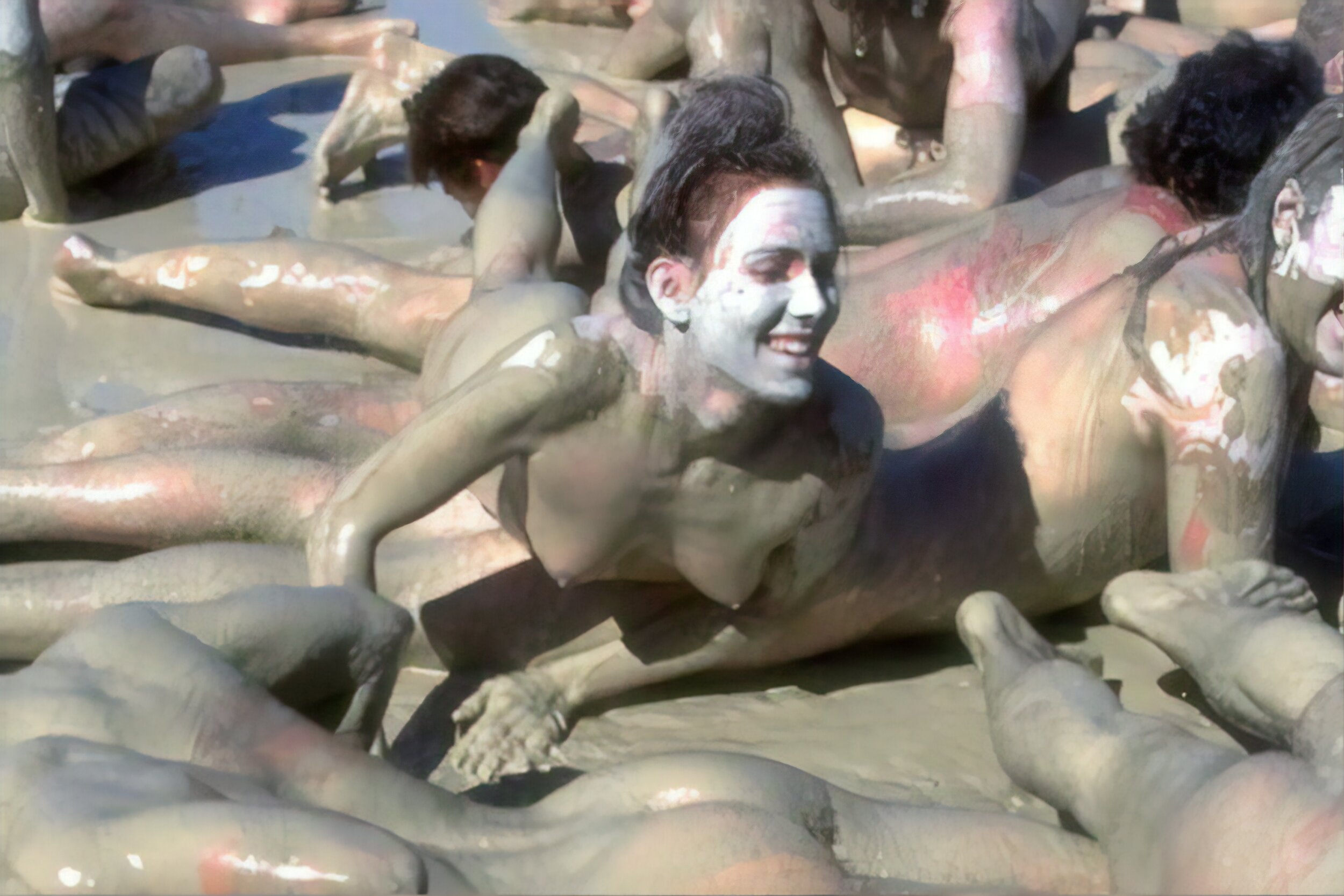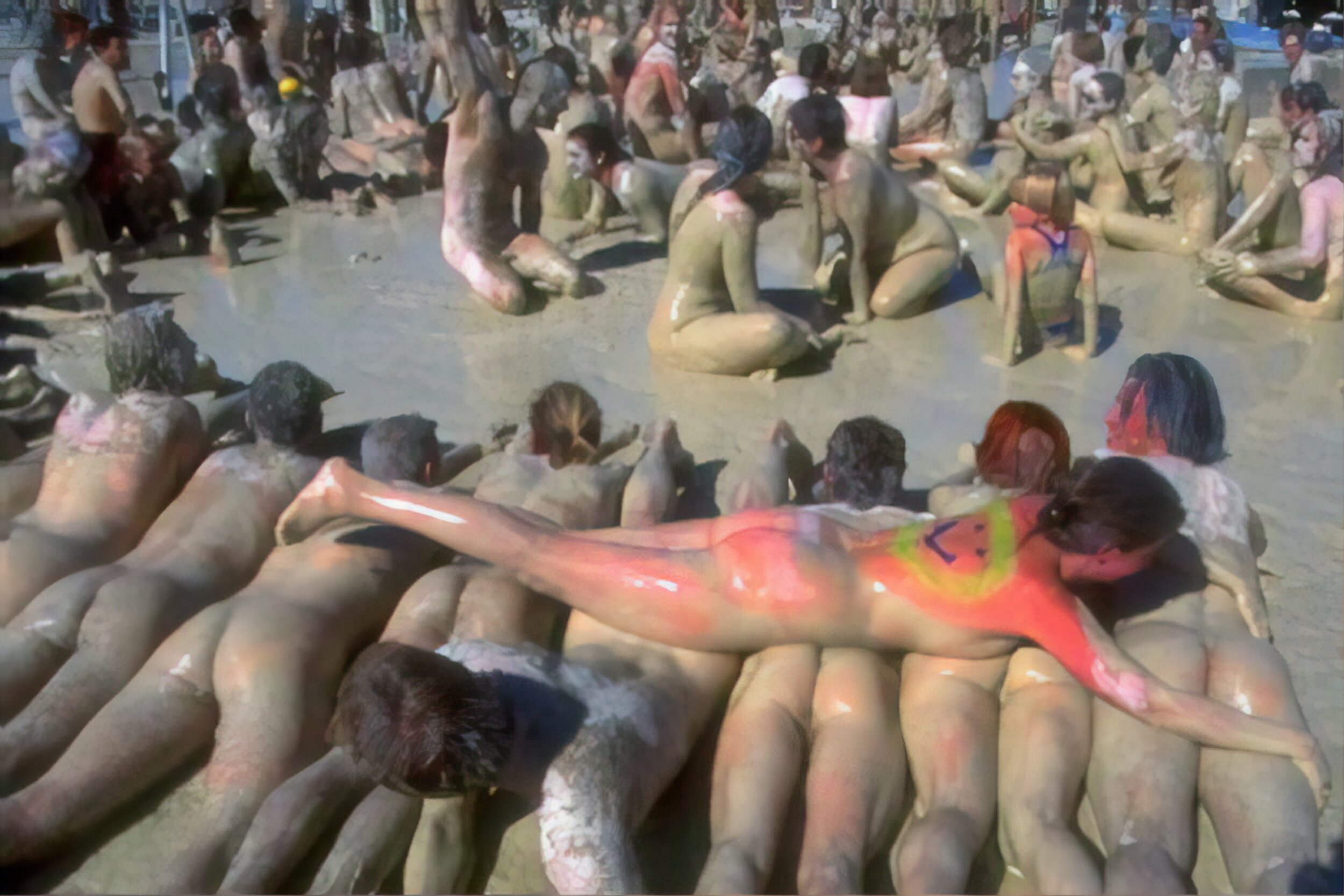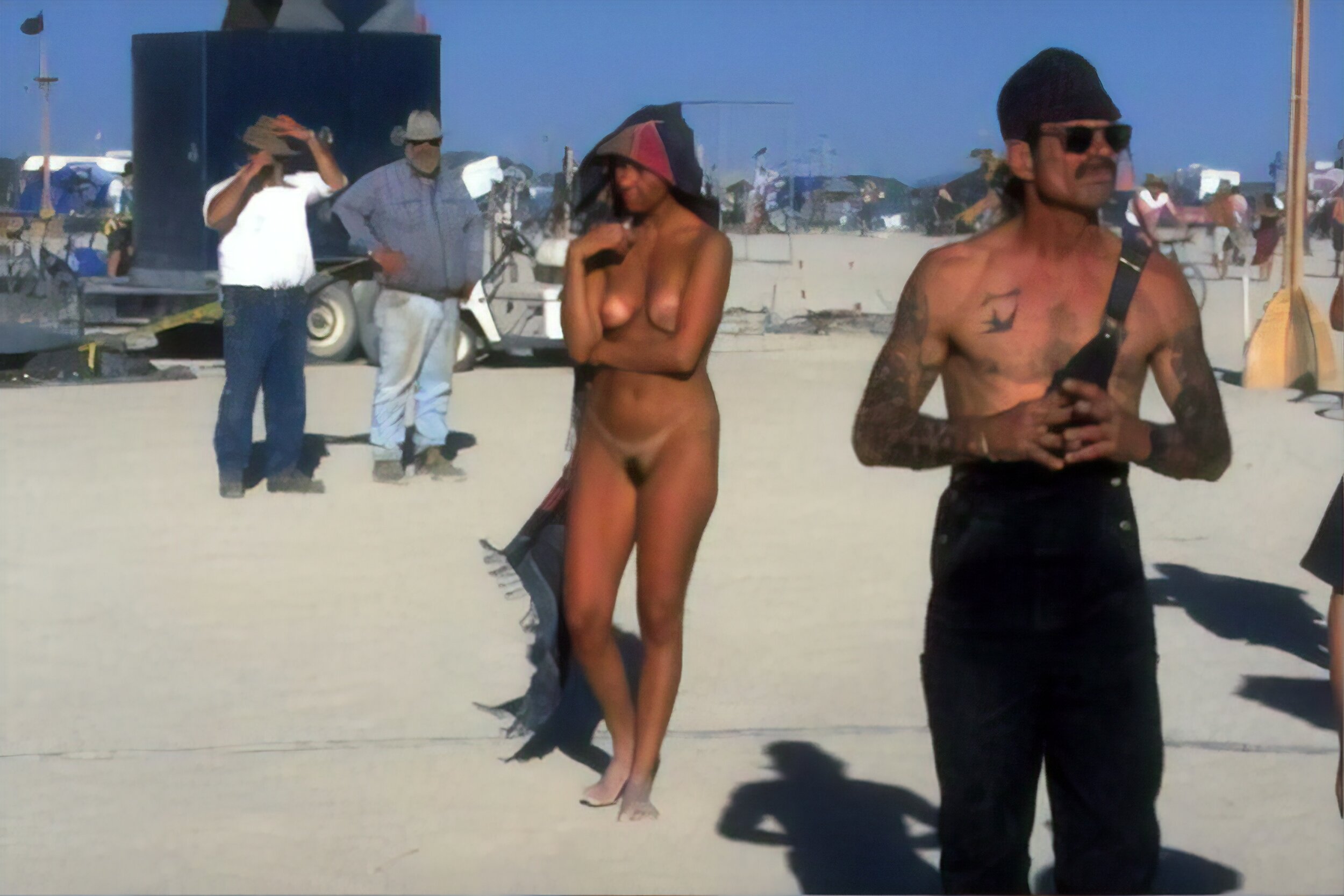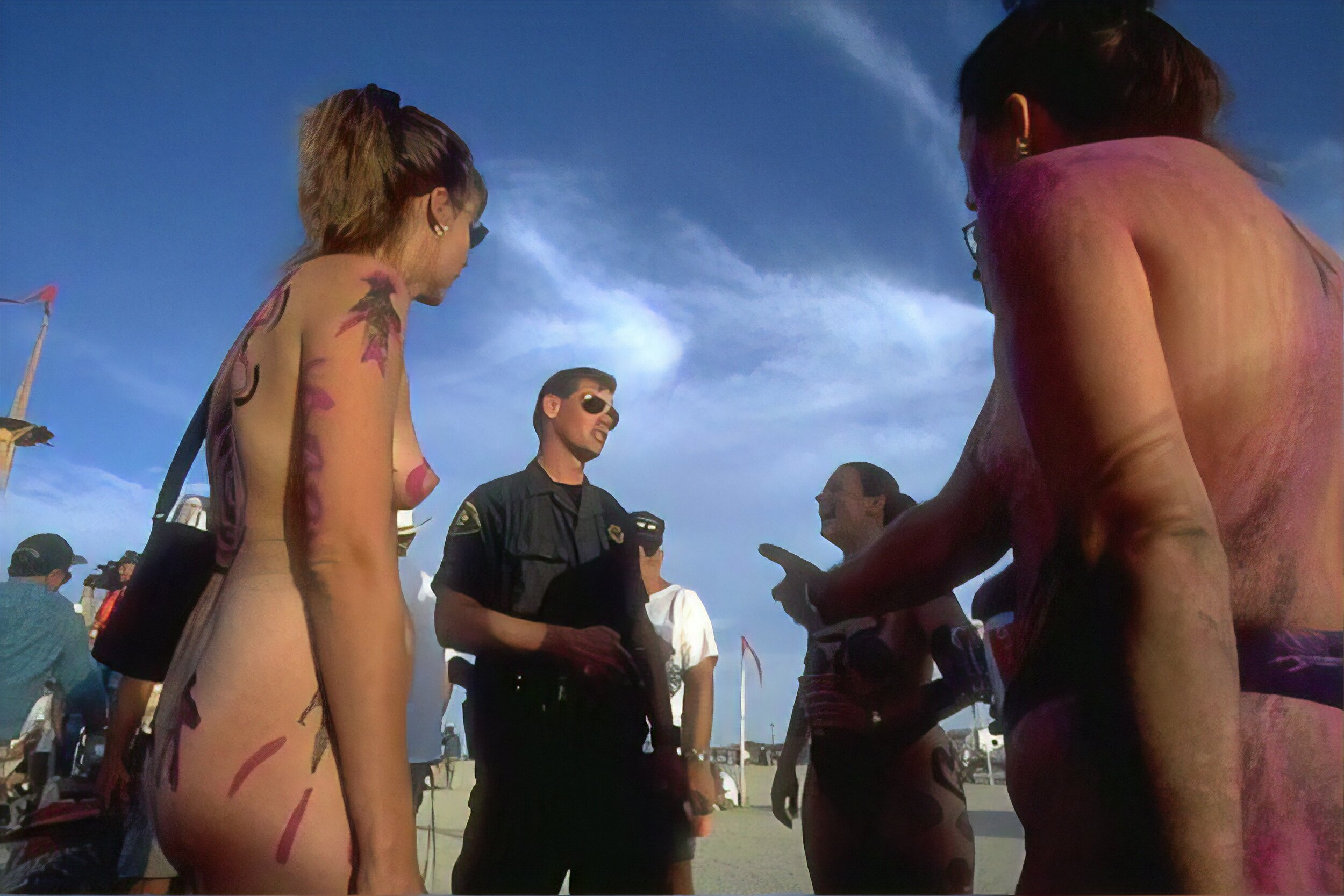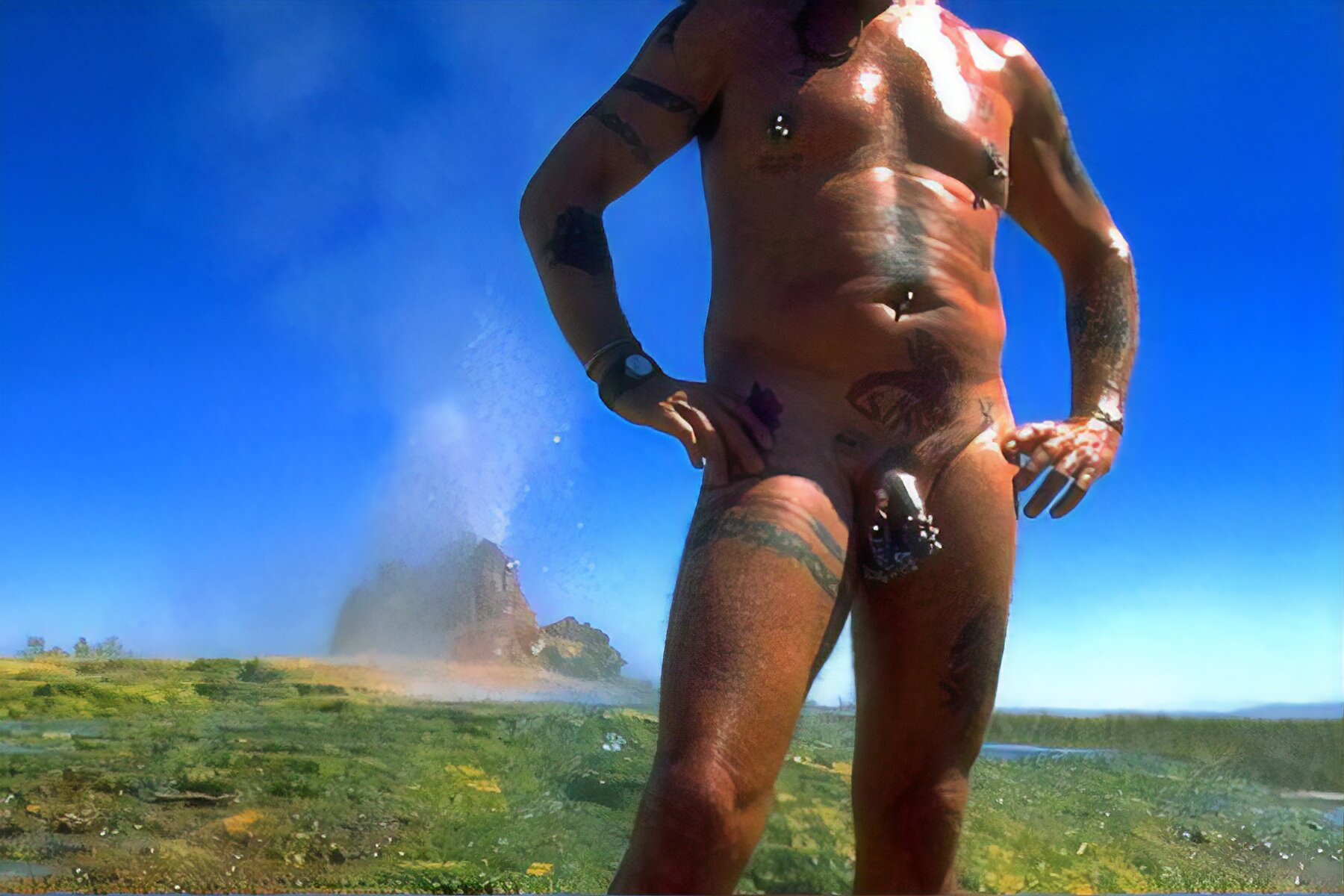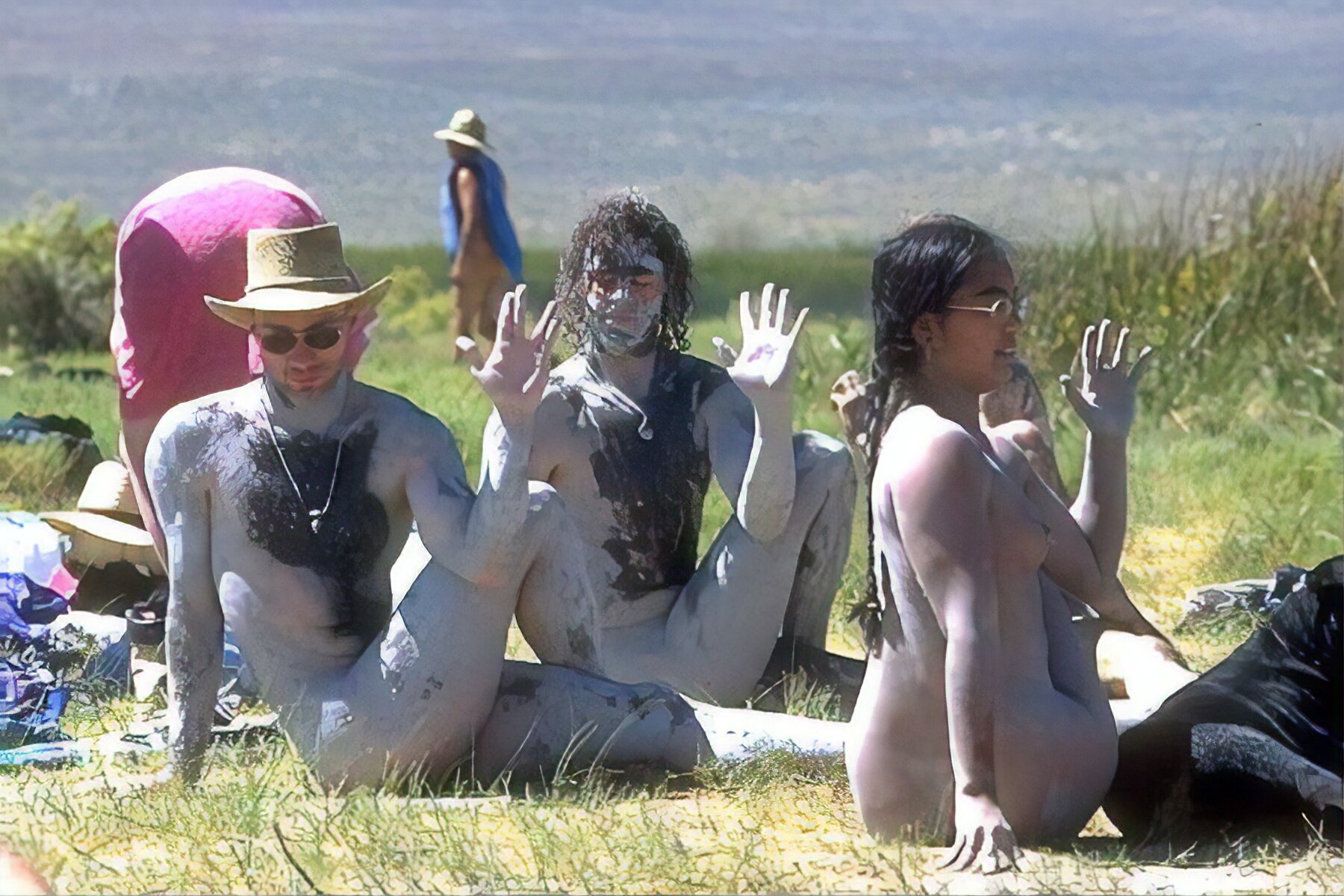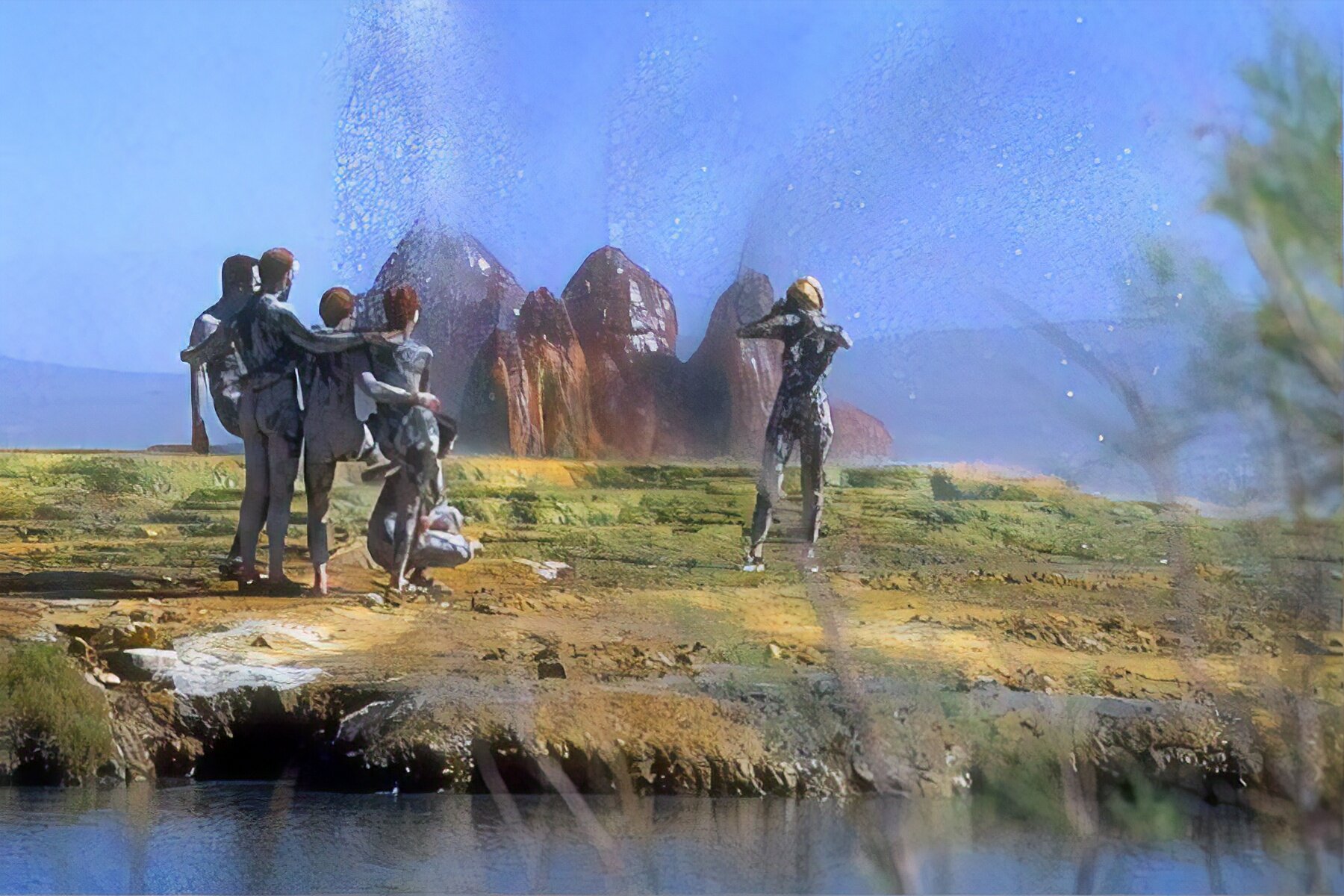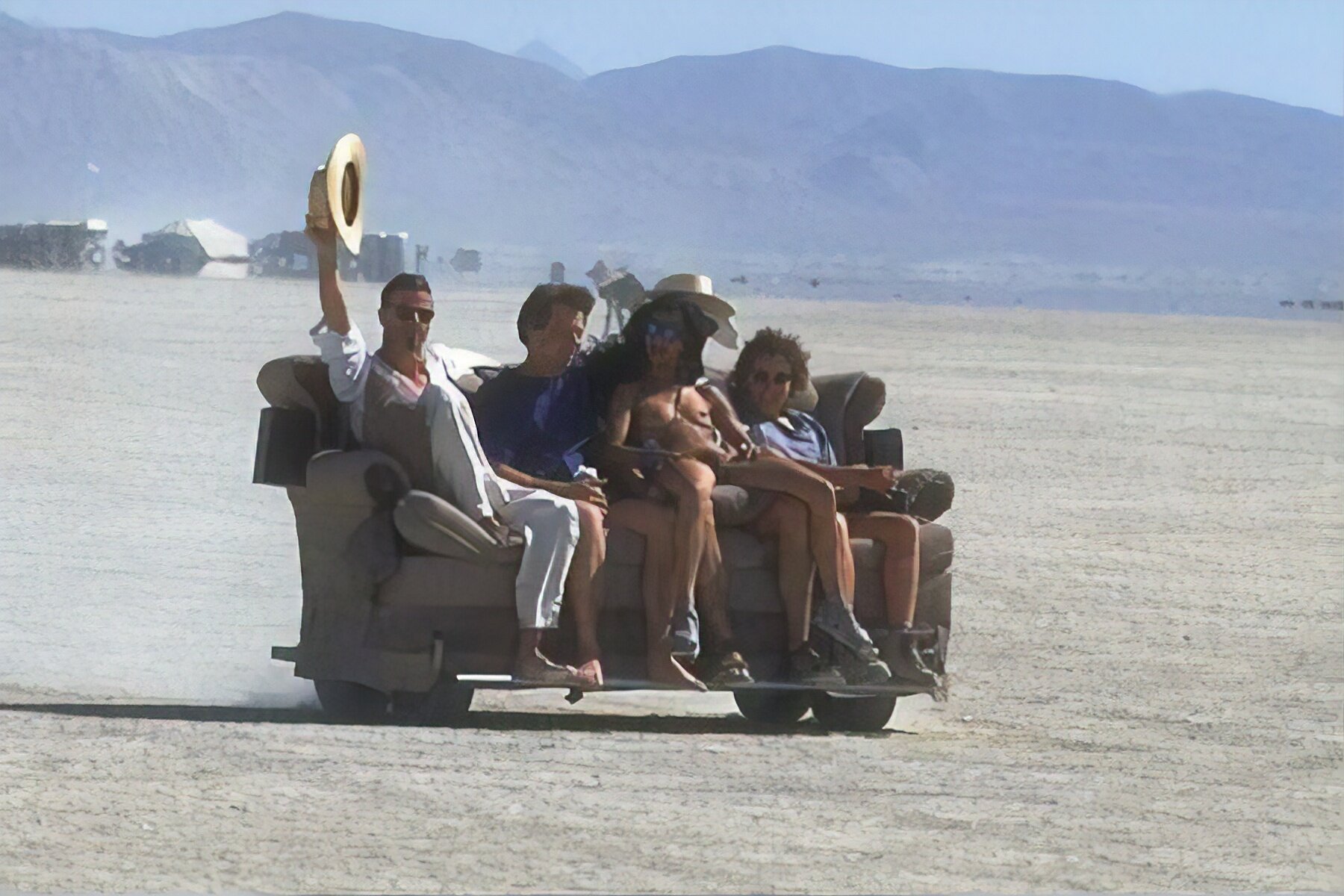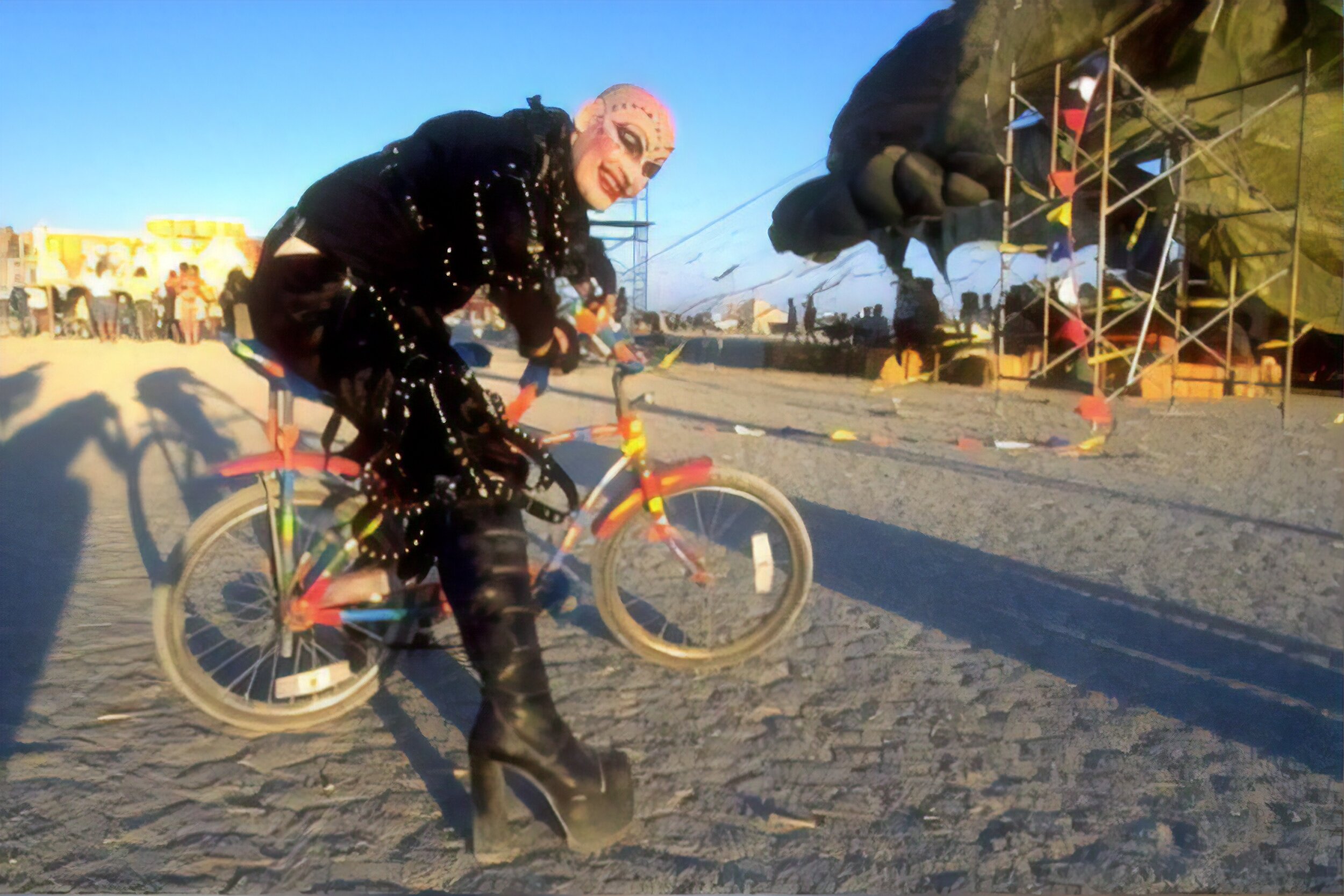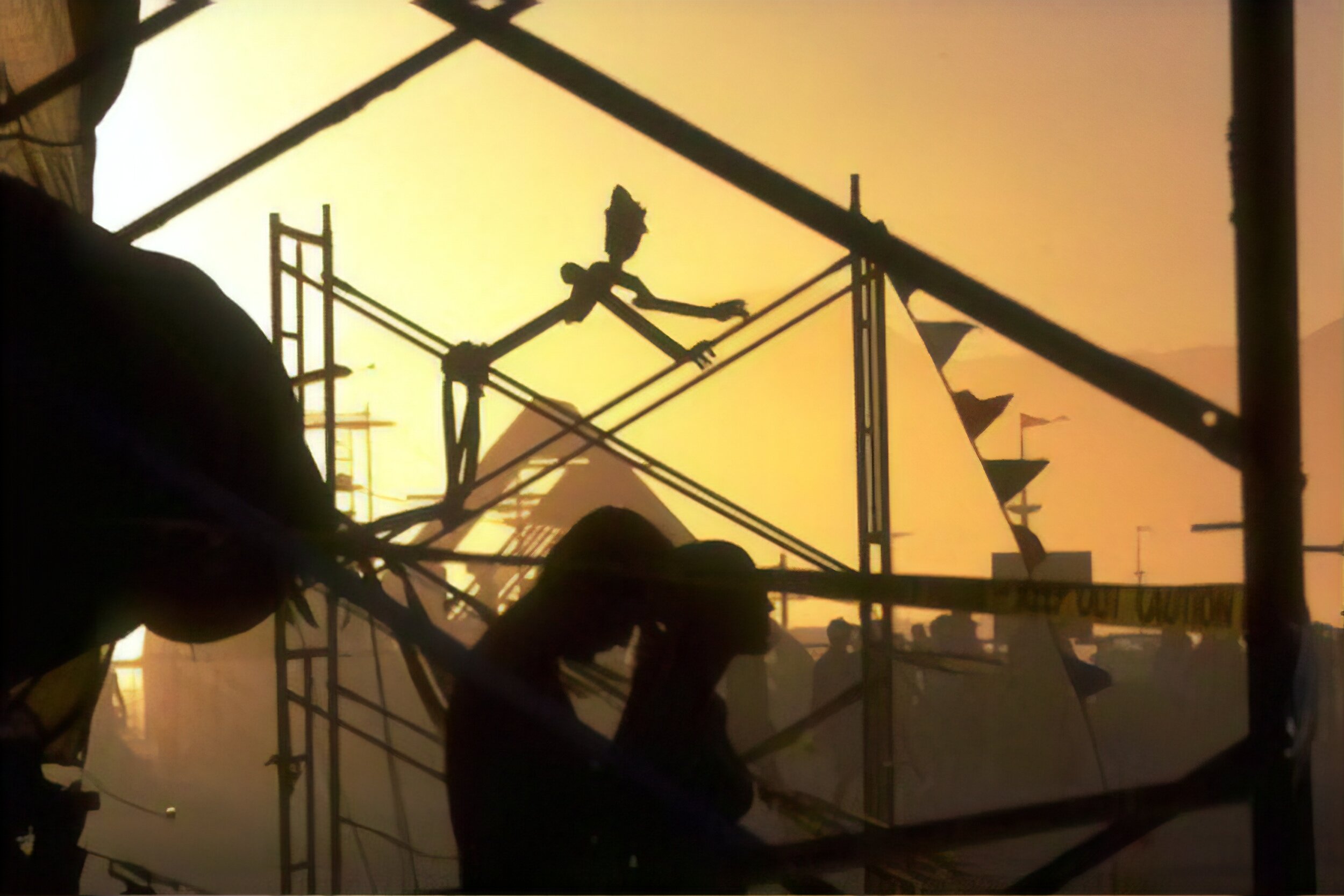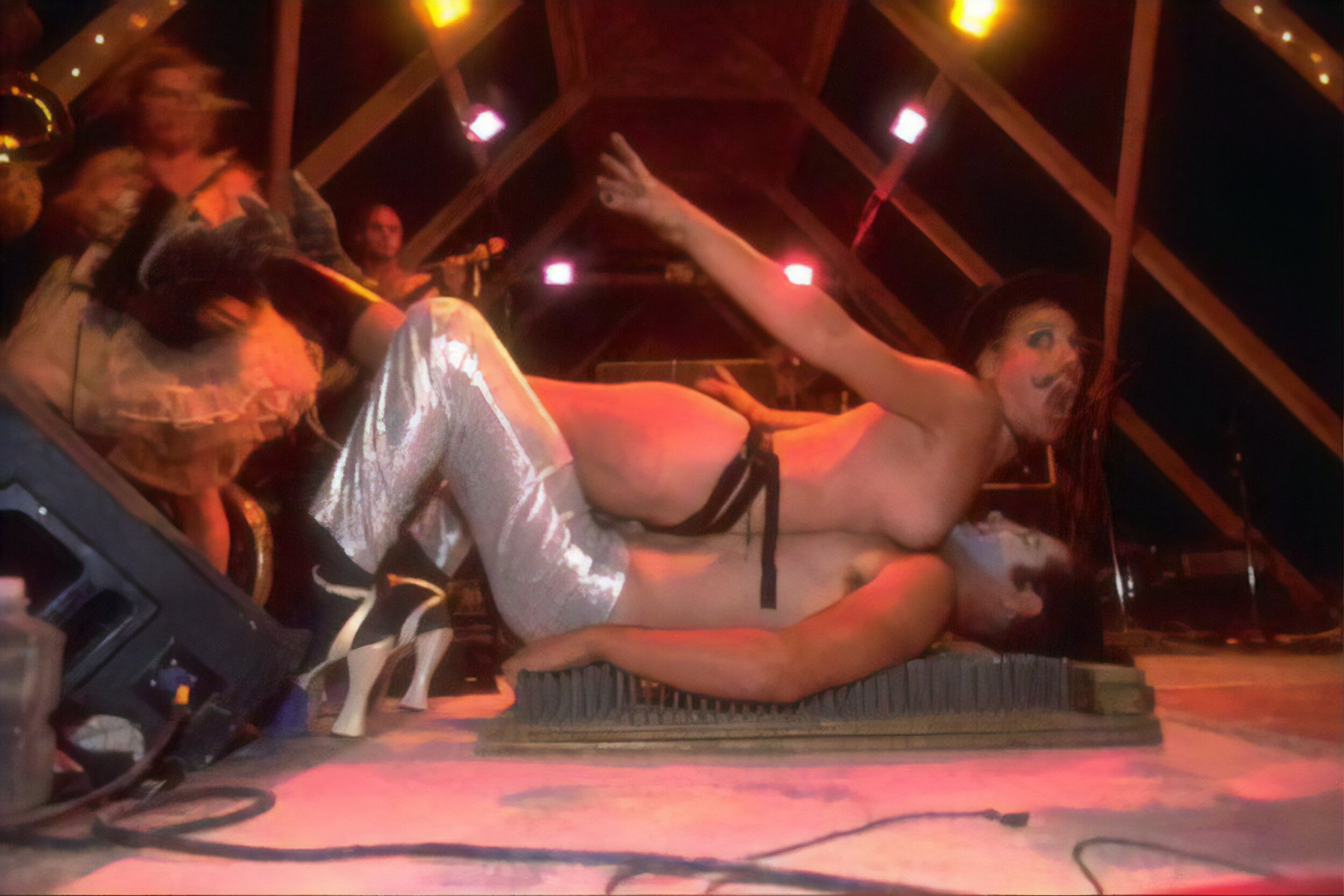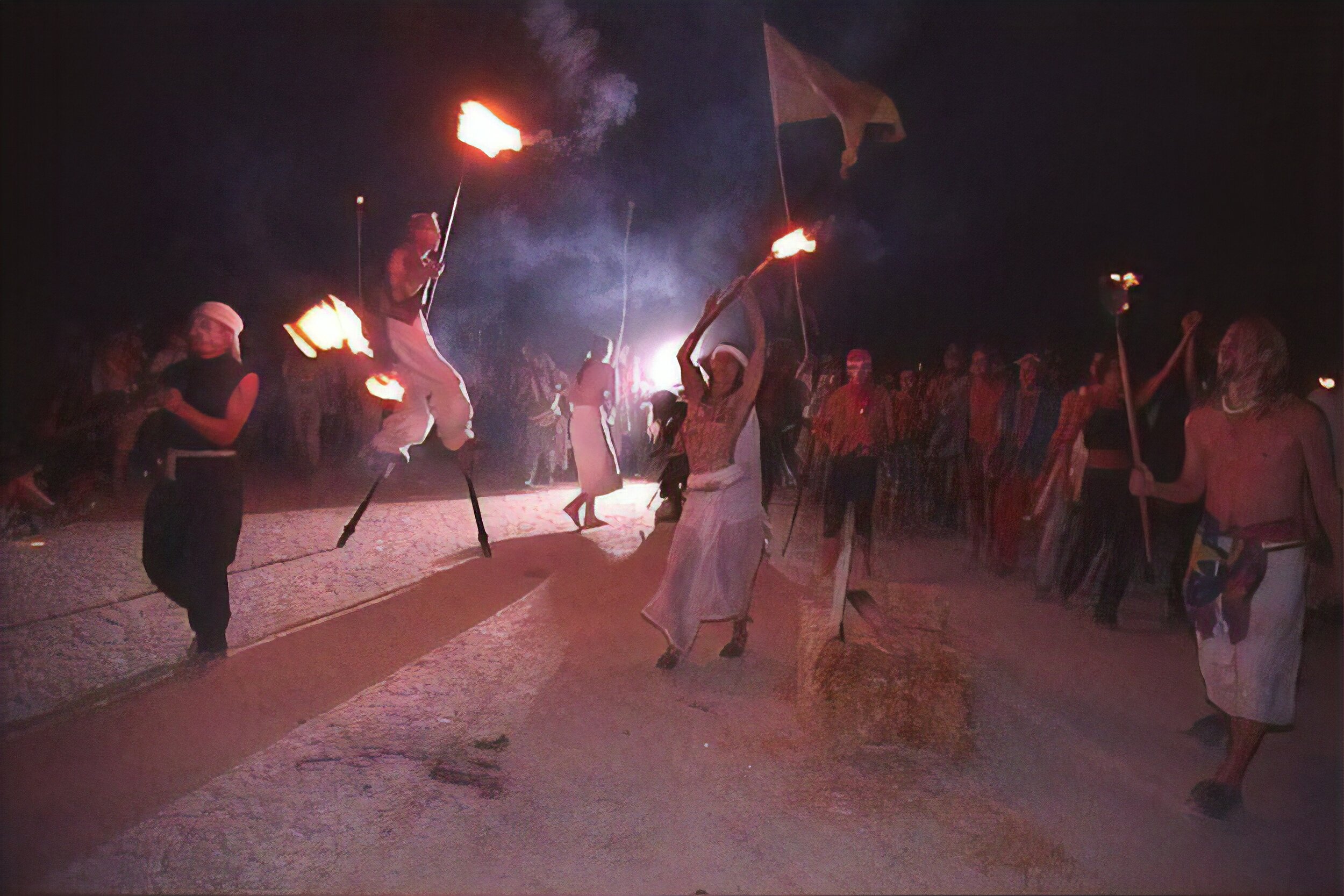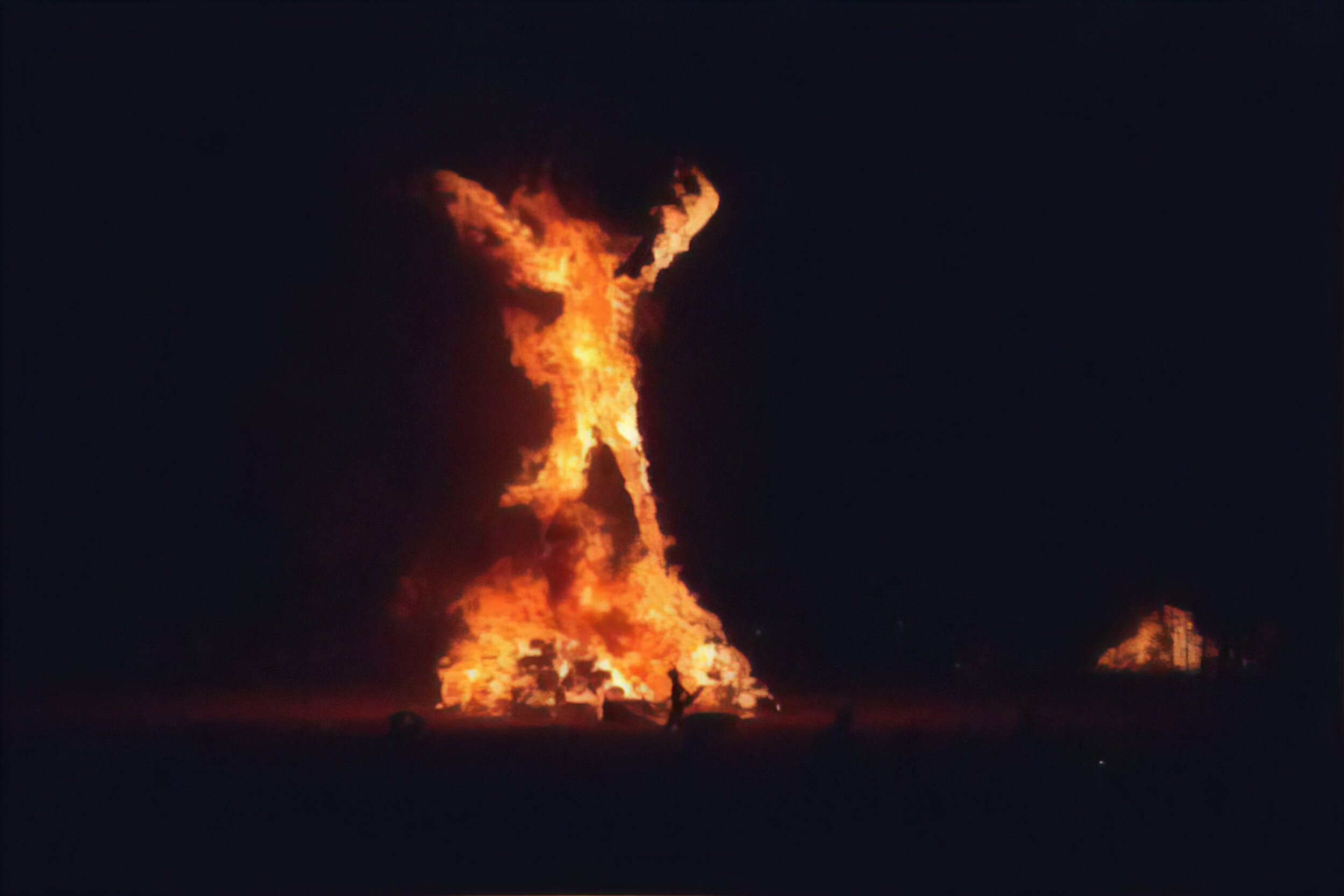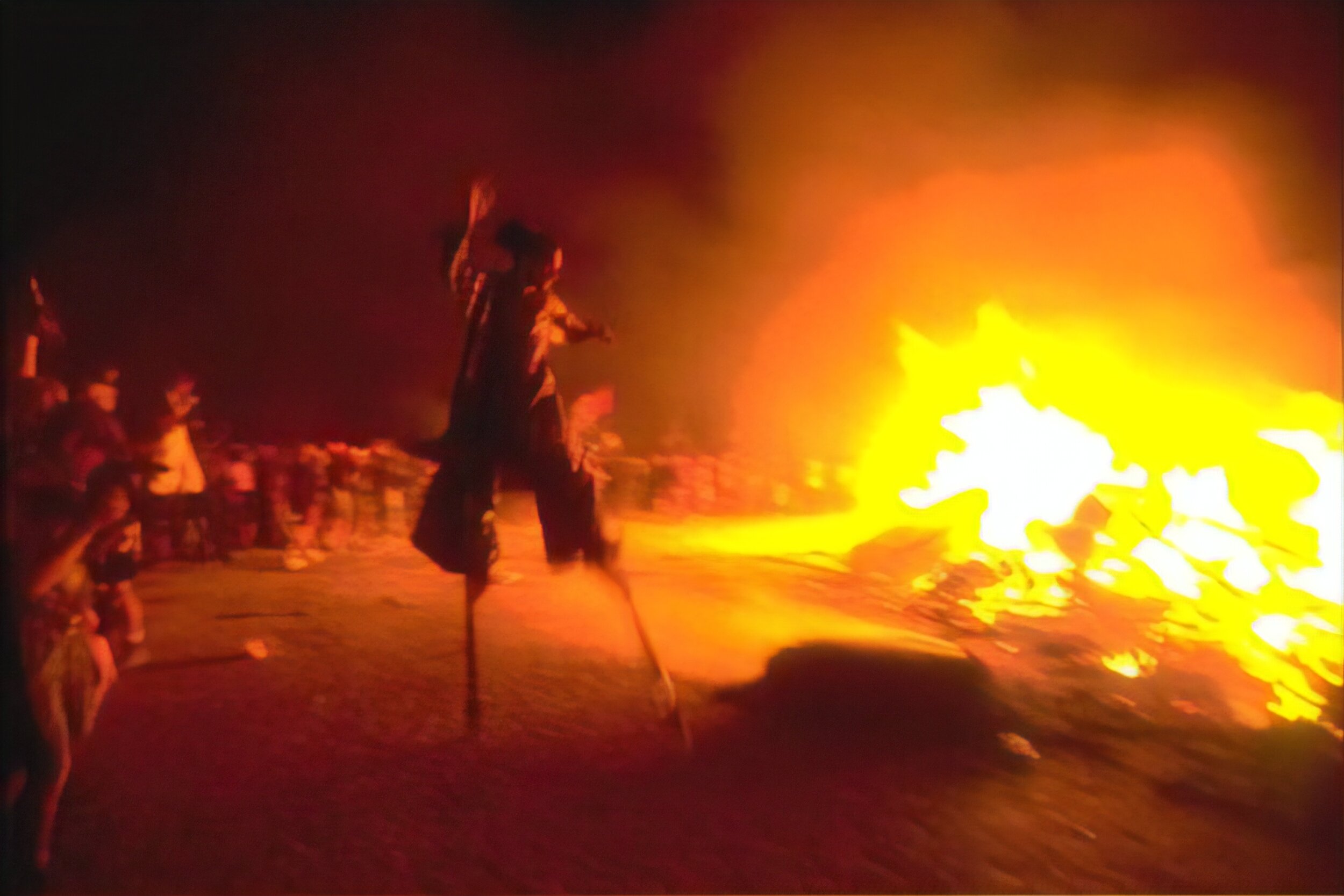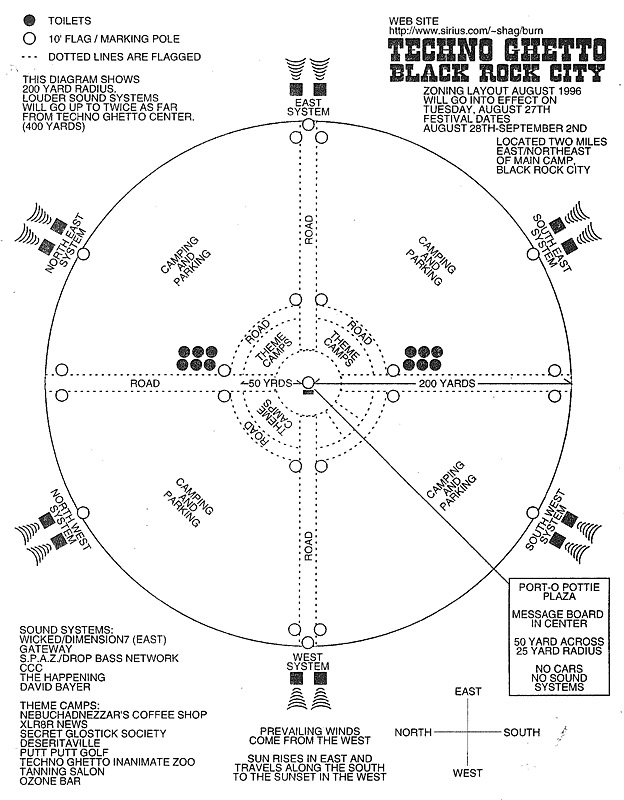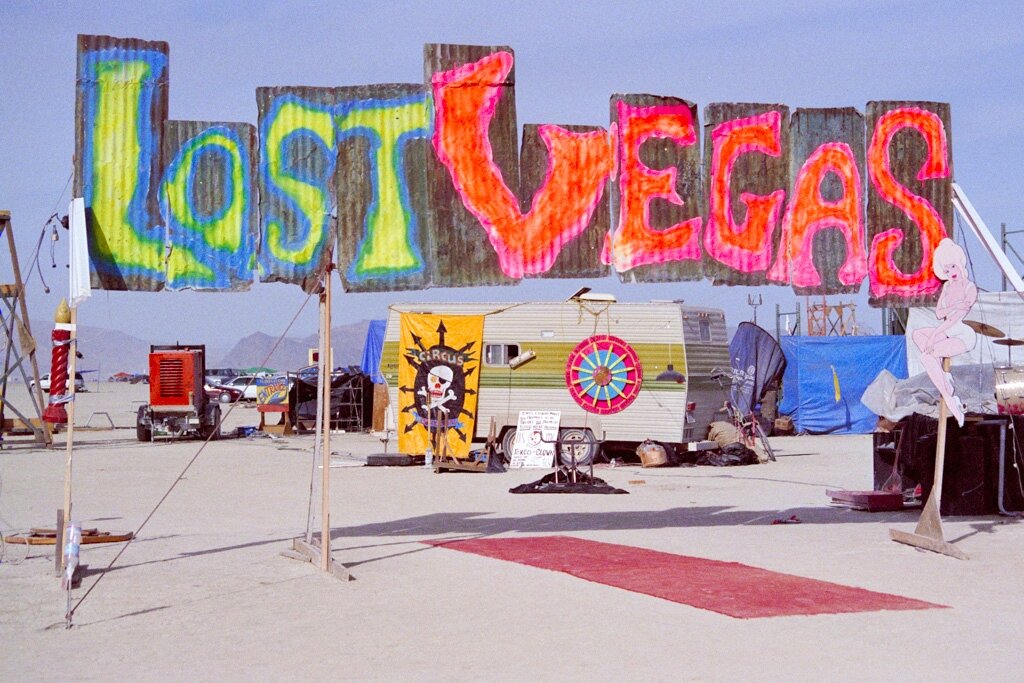Burning Man 1996
Burning Man 1996: Helco
One thing most will agree upon: 1996 was a significant year for Burning Man. People died. John Law quit. The event moved locations, returning to its home in 1998. The population again had doubled, now to 8,000 and tickets cost $35.
Wired Article
The first in-depth coverage of Burning Man
Bruce Sterling wrote a cover story for Wired Magazine (see insert), HBO and PBS also covered the event. The organization launched a website, that gained significant tranction. It was the year of the first official theme: Inferno. A Burning Man staffer was killed in an alcohol related injury on the road into Black Rock, and several participants were injured by an intoxicated driver on the playa.
Old time burners proudly wear a shirt that reads: “Burning Man, 1996: Woodstock or Altamont?” Love it or hate it, 1996 was an inflection point for Burning Man.
The Theme
In 1996, Burning Man had its first official art theme: Inferno.
In the years leading up to 1996, Larry Harvey increasingly was thinking of Burning Man as an art and cultural experience, influenced by Will Binzen and Pepe Ozan, among others. In 1995, an unofficial theme, “Good and Evil”, debuted, and in 1996, the theme was formalized with a plot line and a promotion video.
On the playa, Saturday night a play was performed by some of Burning Man principle organizers, with a simple plot line: Satan, via his corporate entity Helco, was to purchase Burning Man. In preparation for the event, the organization created Helco tower, and a mall lined of modified corporate logos being displayed nearby, including “Caca Bell” and Starfucks.
At the end of the play, Larry Harvey is asked to sell Burning Man to Helco. After hesitation he yells “I can’t do it! I can’t do it! …. Burning Man doesn’t belong to me. It belongs to you. What should I do?” A fight breaks out on stage, which migrates to the Helco plaza, reaching a climatic end with John Law climbing Helco tower, setting it afire by detonating explosives and bag filled with liquid fuel (rigged by Kimric Smythe). As the building burst into flame, Law barely escapes on a zip line, crashing through a neon tube display he created, which spelled out CONSUME.
SRL alumnus Kal Spelletich had supervised the building of the mall, with Flynn Mauthe building the Helco Tower, whose logo was scavenged from a Payless shoe store sign. Another SRL veteran Christian Ristow, who later ran RoboChrist Industries in Los Angeles, managed the Saturday night. Ristow’s robotic machine, the Subjugator, which he operated by remote control was a centerpiece of the destruction.
Thousands filed through the Gates of Hell, created by Kal Spelletich. … "Abandon all hope, you who enter here." Kal also created Cerberus, the three-headed hound of Hell, an animated fire spewing sculpture made of metal.
John Law and Chris Campbell, who constructed the Man in 1996, installed a neon smiley face on the Man and set a timer to display the face for three seconds at random intervals. When Larry Harvey learned of the prank he instructed Dan Miller to lower the Man and remove the neon. Chris Campbell recovered it, and it therefore survived the Burn and was recently displayed at John Law’s Neon Art show in San Francisco, and is available for sale to any interested (and wealthy) collectors; contact us for details.
SOMAR Arts Gathering
On July 26 and 27th, Burning Man held the third consecutive fund-raiser/promotional event at SOMAR Galley, a former foundry.
By 1996, Larry Harvey had intensified efforts to “bring the desert back to the city”. The Black Rock founders were becoming active in the San Francisco art and theater scene, but the most visible event was the annual SOMAR Arts Gathering. The gathering served multiple purposes. First, it raised cash at a time in the annual cycle that the organization was most cash poor. In 1996, most of the cash for Burning Man came in the form of cash paid at the gate. But most expenses were incurred in the months before the event; the cash earned at the door and from the bar at SOMAR helped the event run during the lean month.
In addition to financial requirements, the SOMAR event gave easy access to local journalists to the Burning Man culture, and provided an easy opportunity for media coverage. News stories would emerge in the days following the SOMAR event, giving well-timed exposure to the desert gathering.
The Event
In 1996, the look of the event began to significantly change. The population had grown from 4,000 to 8,000. The Man was placed on a pyramid, designed by Dan Miller, raising him to 50 feet tall. Dan demonstrates the technique for raising the Man in Chris Campbell's kitchen in 1996 (see video insert by Scott Beale).
The Man itself changed its appearance, as Chris Campbell takes over its design, introducing the modern curved ribbing and a different face.
More theater was introduced, with a performance of “Helco” by the organizers of the event, an art parade and demonstration the "Seemen" troupe, an offshoot of Survival Research Labs. Pepe Ozan staged a large scale opera (read community comments about the event here)
Installation art expanded, including the memorable “Piano Bell” by Steve Heck (see below).
Saturday Night Theater
“In the spirit of reconnecting more people to the raising experience, I created a fire caldron and placed it in Center Camp. On the first day of the event, I lit a fire in it with the sun and a magnifying glass. Then I put the word out that this fire would be used to light the Man and that it was up to the community to keep the flame going 24/7 throughout the event. By doing so, you would be an integral link in raising the Man in flames. Then I walked away…the word must have spread, when I came by during the heat of the afternoons to peek, it was still going and by Burn night it was raging strong!”
On Saturday night, some of the organizers of Burning Man staged a theatrical show, which culminated in the burning of the Helco village, followed by Pepe Ozan’s The Arrival of Empress Zoe opera. Larry Harvey recalled the event:
On Saturday night we staged a little show in central camp. Flash reprised his role, now known as Papa Satan. He sat stage right upon a throne surrounded by beguiling temptresses. Behind him stood a group of corporate mascots. They represented HELCO’s board of directors. I remember Aunt Jemima, the Jolly Green Giant, and Mr. Klean. Will Roger played Mr. Klean. Clutching a rag and a spray bottle filled with kerosene, he at one point set fire to the stage…
Three times I was tempted to sign over the property rights to Burning Man and Black Rock City by HELCO’s attorney, played by Stuart Mangram. Three times I refused and reeled back. Turning toward the audience, pen and contract still in hand, I finally shouted, “I can’t sign this! I don’t own Black Rock City! Burning Man belongs to all of you! You have to decide!” Everyone present, of course, opted not to sell out. Satan was then chained to the back of a truck and trundled off at the head of a procession into the Inferno.
Once HELCO Tower was reduced to seething embers, the crowd continued across the desert, ending its journey at the City of Dis. This installation and performance was created and directed by artist Pepe Ozan who entitled the performance The Arrival of the Empress Zoe. With proper operatic pomp, it enacted the arrival of a soul in Hell. In that year's theme announcement, I alluded to it as concealing, "…the Ultimate Pit - a hidden and unhealing wound... this chasm is a fountainhead of boundless rage, appalling shame, and unendurable loneliness.". This is, in fact, a literal rendition of the symptoms of narcissistic personality disorder, the premier mental illness in our age of mass consumption.
Larry Harvey -- The Early Years -- Reflections on Interactive Performance
Music
“In 1996 “the rave was moved downwind and a mile out, with a clearly defined road leading to it. Though the previous year’s issues were resolved, the distance and lack of connection with the rest of the city proved to be problematic. A breakdown of civic standards and community created chaos, ultimately resulting in serious injuries occurring to rave participants. The Burning Man organizers, and I in particular, were devastated by the experience, and vowed that no such incident would ever occur again.””
Live bands and DJ’s had a more significant impact in 1996 than in prior years. Live acts like Idiot Flesh and Polkacide performed. Turbo Ted organized Techno Ghetto a mile north of the main camp. Because Techno Ghetto (aka “The Rave Camp”) was a mile from the action, people were driving, sometimes intoxicated and often at high speeds between the areas. One intoxicated driver ran over a tent before crashing his car, seriously injuring three participants, and leading to a new city organization in future years (see insert).
Other musical performers included:
Idiot Flesh, Burning Man
The Venusians
Tchkling!
Wicked
SPaZ
CCC
The Happening
David Bayer
The Cleanup
“Black Rock City 1996 had disappeared — mostly. The staff had retreated back to San Francisco except for John Law and a small skeleton crew — he credits Chicken John, Chris DeMonterey, Canessa and one or two other hardy souls — who spent week bent-backed, picking up debris over the city’s mile wide footprint, tidying in the aftermath of the world’s wildest party.”
The cleanup after 1996 was challenging. John Law, Vanessa Kummerle and others spent weeks cleaning up the playa. Summer Burkes wrote this account of the aftermath:
Jesse Wack and other Hard Times Bike Club [Ed note: later known as the Black Label Bike Club] and Cyclecide Bike Rodeo members came with Cirkus Redickuless and the Know-Nothing Circus. They were the first real DPW, in ’95 – though the term came later. Flynn set the stage for Tony Coyote to come in and cheerfully rule things, loosely but tightly. Cyclecide and the Hard Times Bike Club were the grunts cleaning up in '96.
San Francisco catalyst and Cirkus Redickuless ringmonster Chicken John was a hardworking DPW type who wore various hats, including one he stole from the Rangers. Cyclecide co-founders Jarico Reesce and John Joyce ring-led the bike freaks to an extent.
Pedal Camp became the place to be, an official camp, in '95 or '96, with Jarico, Big Daddy, Dannygirl Waters, Ratgirl, Loid Mongoloid, and other members of the Heavy Pedal Cyclecide Bike Rodeo out of San Francisco (which this writer joined in ’98 as well). Demilitia, Zsuzs, Mateo Extra Action, Johnny Feral, and several others from Minneapolis also built and struck the city. A few curious locals like Cowboy Carl and Cowboy Bob also joined the tribe.
Summer Burkes - Early Man: Proto-DPW
The End of Burning Man?
1996 City Map shows the addition of “ring road” and a no build zone, giving a clear view of the man from the city.
On August 27th, the evening before the event began, Michael Furey died in a motorcycle accident. In addition, late Sunday night/early Monday morning a drunk and drugged driver ran over a tent with two people inside, and then crashed his car spilling scalding radiator fluid all over another woman. All three lived, although one was permanently injured (and received compensation from Burning Man’s insurance). The driver, Larry Dean Hudson, Jr. was arrested.
These accidents contributed to a change in direction for the event. First, there had been a growing attitude that the event was far too large. Many early contributors, mainly Cacophony Society members, viewed the event as lighthearted fun - an excuse to get away from San Francisco or LA, and blow stuff up and do things that weren’t safe in a populated area. When the event was into the thousands, the fundamental purpose of the event was no longer possible. It wasn’t safe to drive in the dark across the playa because it was littered with tents. Guns were a problem, as were explosives.
And there was also the fact that when the event was small, even fairly dysfunctional individuals could function together, with people keeping each other in line. The event was now drawing dysfunctional people who lacked safety net that the social aspects of the Cacophony Society had afforded. The controlled wacky misadventures of tuxedo wearing pranksters was being crowded out by a harder edged group of strangers, some of whom were finding the desert to be an environment to act recklessly.
“At night, the level of vehicular assholishness gets even worse. We’ve nearly gotten plowed several times by idiots speeding their way out to rave camp … The way things are going, it’s only a matter of time before someone gets hit.”
As detailed below, Michael Furey died because of his own extremely reckless behavior. The accident that injured three during the event occurred because of a combination of factors, including reckless behavior of the driver, but also because of the design of the event: allowing cars to drive on the playa and placing a camp over a mile away from center camp resulted in a predictable accident. People were commenting on the obvious risks cars posed to campers. Adrian Roberts of Piss Clear, the alternative playa newspaper, wrote in 1996 before the accidents: “At night, the level of vehicular assholishness gets even worse. We’ve nearly gotten plowed several times by idiots speeding their way out to rave camp … The way things are going, it’s only a matter of time before someone gets hit. “
Culturally, the mood was dark by 1996. The Helco theme, while not intended to be dark, was misunderstood by some as promoting anarchy. One Burning Man artist remembers that 1996 “was clearly not a sustainable event. That was an apocalyptic event. Things were going wrong. It felt like we were at war. But there was this curious sense that there was something very important going on…” (From This is Burning Man, Brian Doherty)
Some viewed the accidents as not only predictable, but unavoidable. By the end of 1996, some, including John Law, vowed the event would never occur again. Others shared the sentiment. Larry Harvey and Michael Mikel did not. While Law and Mikel both had come to Burning Man from the Cacophony Society, Harvey and Mikel over time began to have a more organized vision of the event, while traditional Cacophony members stuck to a mantra of “Keeping the Playa Safe for Anarchy”.
Harvey, had increasingly seen the event as a cultural movement, and art focused event. He also had devoted his entire work life to Burning Man, arguably the only long term job he ever held. His identity also appeared to be deeply enmeshed with the event. Ending it was not an option for him.
Michael Mikel’s views in 1996 were more subject to doubt. On one hand, he had history with John Law and the Cacophony Society. But for years he had taken steps that were far from promoting anarchy on the playa. He had established the Black Rock Rangers, a civic minded group to help wrangle lost participants and otherwise provide needed civic services. He had also established the Black Rock Gazette. In short, more than anyone else other than Larry Harvey, he was changing the cultural direction of Burning Man toward the modern Black Rock City.
By the end of the event in 1996, Law was openly telling people that it was the last Burning Man. Larry reported hearing that his personal safety was in danger, and that he should leave the event. Chris Radcliffe reported trying to strangle Larry when he tied to suggest John Law bore responsibility for Furey’s death, forcing Larry to drink absinthe with him, and then chocking him again. Larry flatly denies this happened.
At this point, Burning Man was run by Larry, John Law and Michael Mikel. With Law wanting to end the event, and Larry wanting it to continue, the support of Mikel was critical. Near the end of the event, Mikel visited Larry in his trailer, and they discussed the turmoil of the event, and Larry asked the pivotal question: “Are you with me, Michael.” “I’m with you.” Michael replied. After he left, Larry cried.
Law would leave the event. Larry and Michael would continue on, moving forward with more restrictions. After 1996, chaos was no longer a central goal. Community was now the word most likely to be bandied about.
Beyond cultural issues, two forces were also working against Burning Man. First, the BLM was no longer willing to ignore the event and made it clear that permits would not be flowing freely. This lead the organization to abandon Black Rock Desert in 1997 and 1998, moving the event to private land.
In addition, Burning Man was losing money. It ended 1996, $30,000 in debt. The following year it would face even deeper financial issues. The organization estimated around a third of the attendees did not pay admission (or even more if you counted the crowds that streamed in for the evening the of the Burn). John Law had helped float the organization, but his credit cards departed along with John following 1996. The organization resorted to begging for money by the end of 1997, and published its expense breakdown to attendees in the months leading up to the 1997 event.
Michael Furey’s Death
There are conflicting accounts surrounding Furey’s death. This account is our best guess of events pulling from multiple sources:
Michael Furey first attended Burning Man around 1993. He had been friends with the members of Polkacide, and has been described as their self-appointed manager. Polkacide had performed at Burning Man in 1995, and played again in 1996. He had been in the band The Grateful Dead Kennedys. He was also a neon-glass bender, and friends, or at least social acquaintances, with John Law and others involved with the organization of the event. According to John Law: “He was, you know, hardcore punk, wonderful guy, really crazy, really excitable and a very Hunter Thompson-esque character. He was very well liked by many people and hated by others because he was pretty much out of control….”
The afternoon of the accident Furey and Tom Ray [a/k/a Pogo] were at the bar at Bruno’s Country Club in Gerlach, the closest town to the playa. Both were visibly intoxicated. They were chatting up two women at the bar, Lisa Galley, an artist from San Francisco, and friend of John Law, and another woman, a friend of Lisa’s from Chicago, who were also in town to attend Burning Man.
In the late afternoon, around 5 or 5:30 p.m.., John Law and Andy Petter entered the bar, and quickly grew concerned about the situation.
In 1996, the relationship with the citizens of Gerlach and the law enforcement community was tenuous, as the events quick growth was impacting the town. Moreover, the owner of Bruno’s had been helpful to the organization and John Law, by allowing them to store equipment without charge on his property. That night his daughter Skeeky was working the bar. Offending Skeeky, or having an encounter with law enforcement, could set back many years of hard work building a bridge between the event and the community.
Law confronted the drunk men, telling them to get back to the desert. However, Furey told him to fuck-off, and to leave them alone. Law describes the situation:
… I’m worried about [Furey and Ray] getting out of control and pissing off or freaking out Skeeky, who’s behind the bar. Lisa, who I knew, who was sitting at the bar and is a pretty level-headed gal, basically they were chatting each other up and … Michael and Tom were trying to get laid, basically. So I couldn’t really do anything about it, so I just forgot about it. I was with my friend Andy Petter, who was heavily involved in organizing at the time as well, and so we left. And that was the last time I saw Furey.
A few hours later, a little before 7:30 p.m., Lisa and her friend decided to leave the bar and head toward the playa. They had a large flat-bed trailer on the back of Lisa’s truck, which had been used to bring supplies from San Francisco. Lisa convinced Ray to load his motorcycle on the flatbed, and ride with them to the playa. But Furey insisted on driving himself.
At first, Furey drove along following Lisa’s pickup truck. But they caught up and then passed John Law’s van, which was pulling an 18 foot trailer, loaded with the Man’s legs. Law wasn’t in the van, which was being driven by Steven Bellaseals (aka “SteveCo”), with Mark Perez in the passenger seat. Both Steve and Mark were helping Law with logistics, and had spent several hours loading the trailer from supplies stored at Burnos.
SteveCo was driving the heavily loaded van around thirty miles-per-hour, well below the 55 mph speed limit for County Road 34, the road that lead to the exit for the Burning Man encampment. Around 7:40 p.m., shortly before sunset, Lisa passed the van near the 11-mile turnoff, where one would turn off County Rd. 34 and entered the playa.
At this point, Furey began to drive circles around the van, as well as the pickup. Lisa, in the faster moving pickup lost sight of the Van and Furey, although it’s likely the accident had occurred behind Lisa, without her knowledge. Regardless, Lisa nor the other occupants of the pickup witnessed the accident, and therefore the account of what happened from this point on is solely that of SteveCo, the driver of Law’s van and Tom Ray, the van’s passenger.
According to the van occupants is that Furey began to play chicken as they drove across the playa, driving straight at them and swerving at the last second. Steven reported finding this to be upsetting, driving a van with a long and heavily loaded trailer. He decided to just drive straight and his current speed.
John Law later described what he had been told about the event by Steven, the van’s driver:
This guy is on a motorcycle and whatever he’s going to do I can’t stop him,” and Michael made a last pass at the van. Steven said it looked like [Furey] was going to hit him and at the last second turned away to the right. Michael, instead of hitting the van dead-on in the center, doing seventy miles an hour, hit the side of the van and was decapitated by the driver’s side rearview mirror.
Note, some verbal accounts report that Furey had done several drive-bys prior to the accident with the van and Furey both swerving at the last minute, with the implication that Steveco’s failure to swerve the last approach contributed to Furey’s just barely failing to clear the van’s mirror. It is hard to believe that a van, pulling a long, loaded trailer, traveling at around 30 miles per hour, would be able to make any type of last minute swerve.
The Pershing County Sheriff made a point of noting that the tire marks of both vehicles were going straight ahead, in a straight line until the last forty feet when they swerved hard to the right. Law again notes:
There was an enormous amount of controversy over this. They were calling Steven a murderer. They were saying that they were doing this stupid thing, playing chicken, and that it was some kind of a challenge or something like that. I don’t believe any of that. I think that pretty much what [Steven] said happened was what happened…. It was just an ugly and horrifying incident. The police did the report. There were no charges filed. Steven and Mark were really upset, but they weren’t drunk and they weren’t on drugs, thank God, at the time. They could have been, but you know they were working, hauling stuff out, so they weren’t.
Vanessa Kuemmerle, who was running the day-to-day Black Rock Rangers operations, was soon at the scene, and set up a perimeter around it. Around 30 minutes later John Law arrived on the scene. Vanessa went to town and notified law enforcement, who arrived on the scene and conducted interviews and documented the accident.
Around 11 p.m., Larry Harvey arrived. Controversially, he repeated “There’s no blood on our hands.” Law and others have interpreted this as Harvey being more concerned with the reputation of the event than the death. Harvey explained that he was in utter shock at hearing about the death, and that his statements were not related to concern over the event, but driven by his own feelings of guilt about the death. He had learned there had been a death and on the way there was ruminating about whether he had, in effect, just killed someone.
John Law concluded:
Michael shouldn’t have died. He was a really fun guy, a great guy, but he was out of control. Steven, I don’t think he ever got over it. I don’t think he’s over it today. And that was only one incident. There were fourteen major accidents that year. It was completely horrifying. Larry and to a lesser degree Michael [Mikel] really didn’t have that much of an idea what was going on in the setup or what was required. I knew we didn’t have the infrastructure, the money, to be as responsible as we needed to be to do the fucking event. We just didn’t and these guys didn’t have a clue. Michael sort of did, but Michael’s not one to rock the boat. Larry had no idea, and when I tried to explain it to him, he didn’t care. He wanted the event to be successful, and he wanted people to be impressed by what we were doing. And it didn’t matter if people could get hurt, killed, whatever, as long as anybody didn’t know about it, it didn’t really matter that much. You can fuck the desert up as long as people don’t think we’re fucking the desert up. It didn’t matter that much.
The Internet
The first Burning Man website was on The Well until after the 1995 event, when the webmaster decided to move on and it needed a new home. In 1996, Burning Man veteran Stuart Mangrum was working at the web design company LVL Interactive in Palo Alto and he offered to develop a new website for Burning Man. ...
Along with the new website, they put together the first real netcast from Burning Man, using steaming technology by MediaCast and internet connectivity through InterNex.Net. In those days I was shooting a lot of video, so I volunteered to help out with the netcast. I would run around the playa shooting video of interesting stuff and then come back to the RV, where Beach would digitize and then upload the video to the website. I remember how excited we were to know that we were sending out photos and video live from the playa, digital pioneers, we were.
Scott Beale Burning Man 1996 Website & Netcast by iSTORM
The Art of 1996
Buddha Head
by: Elise Fried
The wire Buddha head is created by Elise Fried with the help of her neighbors on the playa. She hopes it becomes a benign and blessing presence for you to see the world through.
City of Dis
by: Pepe Ozan
Tour Satan’s private estate whose somber towers enclose the Ultimate Pit — a hidden and unhealing wound, this chasm is a fountainhead of boundless rage, appalling shame, and unendurable loneliness. But that’s not all! This is real! — not like in the movies. More thrills await. Witness the arrival of a soul in Hell, a tribal opera, and an insect ballet.
URL: www.burningmanopera.com
Contact: pepozan@earthlink.net
I then sit on the Aggravator's iron tractor seat and watch an astounding presentation, over by the sinister temple towers of the City of Dis. A formal procession begins with honks, rattles, and electronic squeaks. Pagan hierophants in tall headdresses and silver lamé march in slow step, toting flaming standards of arcane device. Swarms of nude dancers, male and female, caper up in bizarre sword-and-sorcery bondage gear. The soundtrack switches to repeated, insane, bestial screaming. An awe-inspiring insect goddess - a hunchbacked bug on red stilts - comes towering and tipping and tottering into the firelight, like a mad Kafkaesque advent. It's like a cross between Vatican ceremony, Cirque du Soleil, and a necro-erotic cannibal mantis mating ritual. The performers seem ready to burst into a flagellant orgy at any instant, in front of a solid milling crowd of at least 3,000. This sure isn't the sort of thing one sees every day. … I'm really enjoying this.
Bruce Sterling -- Wired Magazine, Issue 4.11 November 1996
Forest of Fire and Ice
by: Jim Mason
Wander through a phantom forest of burning trees. Glinting ice, encrusted on the tangled boughs, drips slowly into a cauldron of fire. Loiter here and listen to the eerie strains of cello and djeridoo.
Contact: jimmason@longnow.org
HELCO
Installations and performances by Kal Spelletich and Seemen, Christian Ristow, John Law, Maya Hayuk, Serena Irwin, Flynn Mauthe, Kimric Smythe, Robert Burke, Tanya, Nick Spelletich, and many other beloved helpers.
HELCO, a supranational conglomerate, is the official sponsor of this year’s Burning Man festival, and also our theme. Enter the Inferno through the neon Gate of Hell, courtesy of San Francisco’s Seemen. Visit HELCO’s corporate headquarters, a demonic strip mall dominated by The Helco Tower, Starfuck’s, Caca Bell, Joe Camel and Submit. Witness Cerberus, Hell’s voracious three-headed hound, as he consumes your favorite packaged products. See the battle between HELCO and Burning Man – who will win possession of our event?
URL: www.burningman.com/art_of_burningman/helco_gallery.html
MudHenge
by: Lisa Galli
Lisa Galli’s contemporary interpretation of Stonehenge is a ring of graceful sloping monoliths which enclose a mud pit. Worship here and wallow daily.
Ozymandias
"A vast and trunkless leg of stone stands in the desert." Behold Ozymandias, romantic relic of a vanished civilization. The pedestal inscription reads "Look on my works ye mighty and despair!"
Piano Bell
Enter a world of pianos at Steve Heck’s Piano Bell, a two-story structure built entirely of pianos. Steve, a piano mover, has a deep attachment to this instrument and provides you with a place to pluck, beat, and strum the exposed strings of old pianos. Have a drink at the interior bar while you’re at it.
Read the “Community Comments” (see insert below) for comments about Piano Bell.
Pyramid of the Camera Obscura
by: Chris de Monterey
Crawl through a mysterious labyrinth. See a panoramic view of our encampment cupped like a spectral pool within its secret chamber. Based on a design first conceived by Leonardo da Vinci. A playa landmark since 1994.
Stupa: The Processing of Hope
by: Paul Windsor
Behold the towering Stupa of Limbo. This graceful and imposing pyramid of books and stone will align on a grand axis with Burning Man.
Tinseltown
by: the LA Cacophony Society
The LA Cacophony Society brings you Hollywood as you’ve never seen it before — a gleeful spectacle of flaming Entertainment Industry icons. See the World’s Largest Celluloid Pyre. See Steven Spielberg, Tom Cruise, and Mickey Mouse wallowing in Molten Sin! See shrieking starlets, the exploding box office, and the climactic Detonation of the Oscar.
URL: la.cacophony.org
Community Comments About Buning Man 1996
Twenty Foot Man
by: John Henault and Josh Mon
This musical giant plays the various instruments of which he is made.
Water Woman
by: Ray Cirino
Find her at Stonehenge and bathe between her legs. Read the “Community Comments” (see insert) for comments about Water Woman, 1996.
Map given to participants
Theme Camps
Below is a selection of the camps at Burning Man 1996. from Its a Beach:
Swirl.com (The Buddhist Tent)
Imaginative expression extends to every aspect of Burning Man. "Camping" usually evokes images of dad's musty army surplus tent, or perhaps the nuclear blue polyester "value-tent" triumphantly scored behind the all-weather golf caddy at Outdoor World. While an incalculable number of these timeless classics dot the desert floor, the outsiders and media junkies of the Festival have in one weekend significantly advanced the architecture, technology and, moreover, the artistry of temporary structures. The Tibetan tent of Swirl.com (yes, that's www.swirl.com).Originally created for the Tibetan Freedom Festival in San Francisco, the broad tent is covered with Buddhist sayings and icons. Within, a calming energy gravitates toward the many futons on the floor. The tentmaker (located at www.tenttom.com) lived in Tibet for 9 years and has created tents for the Dalai Lama. The folks of Swirl.com hail from San Diego. Well, not San Diego exactly, we discover, but the tiny "hippy province" of Leucadia, north of SD. Both men in the tent report that they have already got ten naked at the Festival and would not comment on any intake of controlled substances. As with many on the playa, their favorite hour of the Black Rock day is when the sun goes down.
Couch Potato Camp
Last year, a collection of old high school friends (many of them drop-outs) visited the Festival and were displeased with the lack of places to sit (besides the powdery, hard playa bed). Their answer: Couch Potato Camp. Visualize (or at least look at the pictures of) an outdoor screen, a shaded viewing area, a video projection unit and a handful of ratty couches. The couches were "harvested from nature and they shall return...at the Richmond Dump near San Francisco, " reports one of the Couchers. These are serious people with a serious cause. While a satellite dish beams in over 200 channels, the camp's key program comes from the Festival itself. Standing alone and apart from the other camps at the central circle near the Atomic Cafe sits a box reminiscent of a souvenir picture booth, with a semi-working curtain and the words "Your Minute of Fame" painted in large letters. Folks enter the booth, push a button and a minute's worth of their speeches, performance art, silly giggles, sexual activities and other antics are recorded on video. The result is then debuted for all to see at the Couch Potato Camp at midnight that night. Friday night saw about 20 viewers come to the camp at any one time, with lots of casual viewers come and go. "We're purpose ly on the edge [of the camping area]; we aren't set up to be an auditorium." Ironically, the camp hosts report that they, in fact, don't watch TV at home, "that's why this is so special." Couch Potato Camp gets about four hours of sleep each night with an additional scheduled nap time each day between 2-4PM. Their favorite hour of the day is "the magic hour, right after sunset." How would they prefer to see Burning Man represented to the outside world? "Don't tell people how to get here- make it difficult to find." For them, it should require an investment of time and energy and not just a plane ticket or car ride. "You should have to work hard to get here."
Fern Grotto
Out in the southwestern reaches of the Black Rock City suburbs, where the plentiful, colorful campsites give way to the bleak flat expanse of the desert, sits a literal oasis of cool, damp greenery called Fern Grotto. Thirteen large ferns are housed here in a rounded nursery frame with greenhouse shading which is cooled additionally with a slow-drip mist system. Yes, it *is* damn cool (and in every sense of the phrase). As with the majority of residents at Black Rock C ity, this year is their first; though they've been bringing their cave of chlorophyll to an annual private event in the Mojave desert for 9 years. They heard about Burning Man from the Internet (a familiar occurrence) and decided to park in the outer reaches of the Festival, rather than closer in with some of the other elaborate camps. It was a planned action. "Some of the women were wary." Indeed, these self-confessed conservatives debunk the freaked-out techno-pagan Burning Man stereotype. Alcohol is their substance of choice. To date there has been no drug intake or nudity, nor any plans it seems. One of the men, though in the clear minority even in this camp, considers Burning Man "ten steps over the line." Still, he seems well fed, in good spirits and proudly wearing his Hawaiian shirt. These first-timers, who caravaned from various parts of California, definitely deserve credit for their effort. Besides the Grotto, they also house the Bean King. The Bean King, in Mardi Gras fashion, will go forth on Saturday night through the Festival dispensing beans to all who hunger for such sustenance. "We have 85 pounds of beans, more than 500 tortillas and a couple of gallons of salsa."
Palpa de Kooks
Erected in the Burning Man Outback, one of the few wooden structures rises like some unfinished tree house. The place is filled; maybe fifteen people lounge around or slowly swing in hammocks. These folks are ornery. To the first question asking what camp this was, a woman responded immediately, "ours." After a few questions with highly contradictory answers from all parts of the camp, they interrupt us and start asking questions themselves. However, there seemed consensus on a few key facts. They heard about it from someone's boss, who learned about Burning Man from the web site. They are a motorcycle gang named by a four year old (who asked her parents one day if daddy was going out "with that gang of kooks"). They took a group run in the morning, though they "had a few extra chase vehicles" since they had more four-wheeled transport than two. It was also unanimous: no one has had sex yet (they've been busy setting up camp, or at least that's the story).
On other issues they spoke with many voices. This is the first Burning Man for some, the second for others. What's the difference between the two? "Fewer firearms this time," and a perhaps sarcastic "it's exactly as it was last year." Is this a place for kids? "Yes-in the fire," and "I think there's a big cage at Helco for that....." Have they consumed any controlled substances? "Not yet, " "why do you ask?" and "what do you mean by controlled substances?" One kind soul summed up the situation, "We don't speak as a cohesive unit." She was followed by howls of "yes we do!" and "no we don't!" How do they want Burning Man represented to the outside world? "It sucks," "don't come," and "no fun." They summed it up succinctly: "Cold women. Warm beer. No motorcycles. Stay away."
The Grey Wolf
It looks like a raggedly muppet with wheels. Specifically, it's a Honda Elite that's hairy. Does the fur affect the engine cooling? "It doesn't. The radiator is in front," reports "Grey Wolf" owner Martin Gastanaga of Aztech Cyberspace (www.aztech-cs.com). While not currently 100% anatomically correct, there are plans for simulated urination via a windshield wiper sprayer mounted under the furry tail.
Land Sail
Also brought by the Aztech Cyberspace (www.aztech-cs.com) crew, a wheeled land sail threaded its way through the camps slowly pulled by an RV populated by sunning Black City residents perched on the RV roof. Aztech co-honcho and boat captain J. A. "Jay" MacDonald confirms that the black-sailed vehicle does indeed sail on its own, "if there's enough wind."
Egg Head Steve - 1996 Stick, the first one he produced.
Random Recollections
At Fern Grotto camp they had a portable hangar filled with real live ferns and a misting system; it felt *really* good to stand near them during the hot day. In the Chai tent they had really groovy dub playing, soft couches and hot Chai for free in the middle of the cold night.
Some music I recognized being played: Loop Guru / Duniya, Orbital / Orbital 2, Delerium / Semantic Spaces, plenty of Banco de Gaia.
At rave camp there were 3 big soundsystems and several other smaller camps had big speakers as well. At Gateway Sound System, they had a beautiful tower with billowing gossamer black-light-illuminated glowing fabric and Mariposa, a 7-ft. light-green female alien, luminous and beautiful in the black-light, crafted by Maureen. I helped transport and set up the alien. Maureen and I put a container of Gummi Octopus next to her alien and labeled it 'Alien Food'. The octopi, slightly melted from the desert heat and glowing under the black lights, definitely looking like something not of this planet. It got eaten very quickly!
https://www.discogs.com/Koxbox-Live-At-Burning-Man-1996/release/432623
https://www.flickr.com/photos/itsbeach/sets/72157600302591901/
Water Woman came to me when I thought why doesn`t anyone have a shower out in the Blackrock? Then it hit me. Make a woman goddess that sprays water, to contrast Burning Man who is of fire. The woman of water is a needed goddess to clean the dried and dusty bodies so they could cleanse the negatives in their body and mind. More importantly to show that there is nothing more inspiring than the freedom to create at the best festival in the world. For those who stayed up till dawn with us to protect WW from the uninvited low ends, I personally would like to thank you for your courage and loyalty. WW stood up to the fire breathing machine and a mob of stoners one of which(we have on video) threw a burning 2x4 that WW blocked from maybe hurting someone. WW also was the last remaining landmark to guide people back to their camps. She was giving many people showers the next day and most importantly symbolized hope as the first art piece not to burn, but to watch over her people. This was a moving event for myself and many others who told me it made them feel good to see WW still standing the next day. Look forward to a docu-drama video in the fall of 97 that will wet your world. We will be casting dancers in the spring and plan a WW festival of our own in the future.
Ray Cirino creator of WW
Camp Last Vegas (Photo Kristen Ankiewicz)



